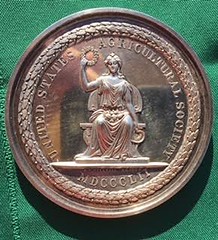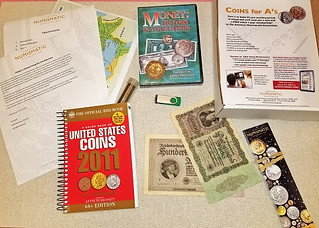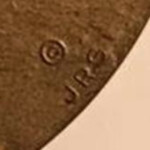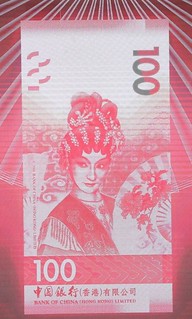
About UsThe Numismatic Bibliomania Society is a non-profit association devoted to the study and enjoyment of numismatic literature. For more information please see our web site at coinbooks.org SubscriptionsThose wishing to become new E-Sylum subscribers (or wishing to Unsubscribe) can go to the following web page link MembershipThere is a membership application available on the web site Membership Application To join, print the application and return it with your check to the address printed on the application. Print/Digital membership is $40 to addresses in the U.S., and $60 elsewhere. A digital-only membership is available for $25. For those without web access, write to: Terry White, Treasurer AsylumFor Asylum mailing address changes and other membership questions, contact Terry at this email address: terrywhite5475@yahoo.com SubmissionsTo submit items for publication in The E-Sylum, write to the Editor at this address: whomren@gmail.com
BUY THE BOOK BEFORE THE COINSale Calendar
|
- WAYNE'S WORDS: THE E-SYLUM JULY 29, 2018
- JOURNAL OF EARLY AMERICAN NUMISMATICS FIRST ISSUE
- NEW BOOK: PIONEER AMERICANISTS
- COIN WORLD REDESIGN IMPLEMENTED
- NEWMAN PORTAL ADDS THE VIRGINIA NUMISMATIST
- MORE ON CIRCULATION/CIRCULATED CAMEO
- MORE ON CONTINENTAL DOLLAR RESEARCH
- BEARDLESS BREEN ON RADIO WITH 1943 BRONZE CENT
- WALTER BREEN AT COIN WORLD AND BEYOND
- BOOK CUTTING IDENTIFICATION THOUGHTS
- NOTES FROM E-SYLUM READERS: JULY 29, 2018
- PNG AUTHENTICATION CERTIFICATES
- NUMIS-MAILRS
- VOCABULARY TERM: BASE LINE
- WILLIAM FREDERICK FRATCHER (1867-1947)
- THE FIRST ANS ERIC P. NEWMAN VISITING SCHOLAR
- ANA ANNOUNCES 2018 HIGHEST HONOR AWARDS
- 2018 ANA PHILADELPHIA WFOM VOLUNTEER BUTTONS
- PCGS TO EXHIBIT BRASHER DOUBLOON AT 2018 WFOM
- WILLIAM AND CHARLES BARBER EXHIBITS AT 2018 WFOM
- ANA STUDENT EDUCATIONAL KITS
- STACK'S BOWERS HONG KONG PRIMITIVE MONEY LOTS
- STACK'S BOWERS ANA PRIMITIVE MONEY HIGHLIGHTS
- HIGHLIGHTS OF HERITAGE AUGUST 2018 PLATINUM SALE
- NUMISMATIC NUGGETS: JULY 29, 2018
- ARCHIVES INTERNATIONAL SALE 49
- HORNBY ISLAND MUNICIPAL TRADE TOKENS
- WORCESTERSHIRE MEDAL SERVICE WINS CONTRACT
- SERIAL NO. 1 CANADIAN $20 NOTE FOUND
- NEW HONG KONG BANKNOTES UNVEILED
- CHINESE HELL MONEY
- VENEZUELA DROPS TWO MORE ZEROS
- ZIMBABWE'S MONEY CHANGERS
- FRANCE CONSIDERS ELIMINATING SMALLEST COINS
- CASHLESS STORES AND RESTAURANTS ON THE RISE
- EVERLEDGER: BLOCKCHAIN TECHNOLOGY FOR ART WORLD
- IN OTHER NEWS: JULY 29, 2018
Click here to access the complete archive
Click here to unsubscribe (scroll down)
To comment or submit articles, reply to whomren@gmail.com
Content presented in The E-Sylum is not necessarily researched or independently fact-checked, and views expressed do not necessarily represent those of the Numismatic Bibliomania Society.
WAYNE'S WORDS: THE E-SYLUM JULY 29, 2018
 New subscribers this week include:
Kevin McCandless and
Erik Goldstein.
Welcome aboard! We now have 5,776 subscribers.
New subscribers this week include:
Kevin McCandless and
Erik Goldstein.
Welcome aboard! We now have 5,776 subscribers.
Thank you for reading The E-Sylum. If you enjoy it, please send me the email addresses of friends you think may enjoy it as well and I'll send them a subscription (but let me know if they are located in the European Union). Contact me at whomren@gmail.com anytime regarding your subscription, or questions, comments or suggestions about our content.
This week we open with the Journal of Early American Numismatics, a Coin World redesign, updates from the Newman Numismatic Portal, and more readers thoughts on the origin of the Continental Dollar.
Other topics this week include the discovery 1943 bronze cent, PNG Authentication Certificates, Numis-Mailrs, the ANA World's Fair of Money exhibit and auction highlights, father and son Mint Engravers William and Charles Barber, primitive money, medal manufacturing, and basket-case economy banknotes.
To learn more about Auctori Plebis tokens, circulated cameos, the U.S. Mint Bicentennial Medal, Undulating Base Lines, Beetle Leg Money, Tampang Tin Hat Money, the King of Yap Island, nymphs and frolicking dolphins, Walter Breen's Piece de Merde and Thomas Paine's coin collection, read on. Have a great week, everyone!
Wayne Homren
Editor, The E-Sylum

JOURNAL OF EARLY AMERICAN NUMISMATICS FIRST ISSUE
The press release announces the first issue of the brand-new Journal of Early American Numismatics. -Editor
 The first issue of the American Numismatic Society’s Journal of Early American Numismatics
(JEAN) has shipped to readers. Replacing The Colonial Newsletter (CNL), JEAN expands on the
depth and breadth of early numismatics in the Americas. At 236 pages, issue 1.1 features five articles:
The first issue of the American Numismatic Society’s Journal of Early American Numismatics
(JEAN) has shipped to readers. Replacing The Colonial Newsletter (CNL), JEAN expands on the
depth and breadth of early numismatics in the Americas. At 236 pages, issue 1.1 features five articles:
1. Fiscal Paper and the Financing of The Revolutionary War: The Link between Speculation in Public Securities and Connecticut Coppers, by JEAN’s editor Christopher R. McDowell
2. (Re-)Discovery: Yale’s Second and Third Noe II-A New England Shillings, by B. D. R. Hellings
3. The Evolution of Spanish and Colonial Coinage and its Influence on the United States, by Brian Stickney
4. Higley Tokens: The Value of Three Pence, by Joseph Daragan
5. The Mysterious Auctori Plebis Tokens, by Jeff Rock
JEAN will be published in June and December of each year, with article submissions anonymously peer-reviewed on a rolling basis by scholars in American numismatics.
The ANS is honoring all current CNL subscriptions in 2018. New subscriptions (and renewed subscriptions beginning with June 2019) are $60 for the calendar year (two issues) plus $5 shipping and handling. New subscribers starting after July 2018 will receive a catch-up copy of issue 1.1 (June 2018).
To submit an article for possible publication, email it to editor Christopher McDowell at CRMcDowell@strausstroy.com. Emma Pratte (epratte@numismatics.org) handles new subscriptions and subscription fulfillment.
Please suggest this journal to your public or university library.
Print ISSN: 2577-5774
Digital ISSN: 2577-5782
To read the complete article, see:
Journal of Early American Numismatics (was Colonial Newsletter)
(http://numismatics.org/store/cnl/)
Christopher McDowell adds:
We are well underway with the next issue of JEAN. I hope to tackle at least one Red Book colonial coinage series an issue and present to our readers the definitive article on the coinage. Issue #2 of JEAN will take on all the mysteries of the Rhode Island ship medal and challenge conventional wisdom that it is an English propaganda piece. In addition, we will be presenting some very new and exciting information on counterfeit coining in New York City during the 1780s.
Gary Trudgen, one of our old friends and a past editor of CNL, has been very hard at work digging deep into the Atlee Brewery story. The old New York City brewery, which eventually become nothing more than a front for illegal counterfeiting, was the early gathering place of die-sinkers and coin-makers who went on to strike several colonial coinages with some even finding work at the U.S. Mint after it opened. I hope to have Issue #2 in our subscribers’ hands right before Christmas so it can be enjoyed over the New Year.
The new publication has been long-awaited, and "turns it up a notch" for the level and quality of research, writing, and editing. This wasn't a name change for the sake of a name change - it was a substantive makeover taking an already great publication and making it even better. At 236 pages the debut issue is more like a full book, and well worth the subscription cost. -Editor
To read the earlier E-Sylum article, see:
JOURNAL OF EARLY AMERICAN NUMISMATICS LAUNCHED
(http://www.coinbooks.org/v21/esylum_v21n22a10.html)
NEW BOOK: PIONEER AMERICANISTS
Numismatists and numismatic bibliophiles have all caught the collecting bug. While non-numismatic, this new book from Oak Knoll Press looks at the lives of eight "Pioneer Americanists", early dealers and collectors of Americana, the important early books, periodicals and ephemera relating to America. -Editor
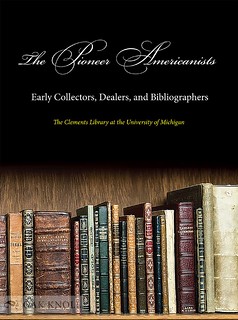 THE PIONEER AMERICANISTS: EARLY COLLECTORS, DEALERS, AND BIBLIOGRAPHERS.
THE PIONEER AMERICANISTS: EARLY COLLECTORS, DEALERS, AND BIBLIOGRAPHERS.
Graffagnino, J. Kevin, Terese Austin, Jayne Ptolemy, and Brian L. Dunnigan (eds.).
• Ann Arbor, MI: William L. Clements Library, 2017.
• 8.75 x 11 inches
h
• ardcover, dust jacket
• 230 pages
• ISBN: 9781881606093
• Price: $50.00
The Pioneer Americanists is a captivating look at the lives and careers of eight generations of outstanding Americanists prior to 1900. Here are autobiographical and contemporary biographical sketches of White Kennett, Isaiah Thomas, James Lenox, Joseph Sabin, John Carter Brown, Lyman Copeland Draper, George Brinley, Jr., and the other noteworthy specialists who created and nurtured the Americana field from the late seventeenth through the nineteenth centuries.
Illustrations from the remarkable collections of the William L. Clements Library and other leading institutional archives complement the texts to provide a panoramic window on the early story of Americana appreciation, collecting, and description. Anyone with a professional or avocational interest in antiquarian Americana will find The Pioneer Americanists a fascinating treasury of information, enlightenment, and inspiration.
For more information, or to order, see:
THE PIONEER AMERICANISTS: EARLY COLLECTORS, DEALERS, AND BIBLIOGRAPHERS.
(https://www.oakknoll.com/pages/books/131308/j-kevin-graffagnino-jayne-ptolemy-terese-austin-brian-l-dunnigan/pioneer-americanists-early-collectors-dealers-and-bibliographers-the)
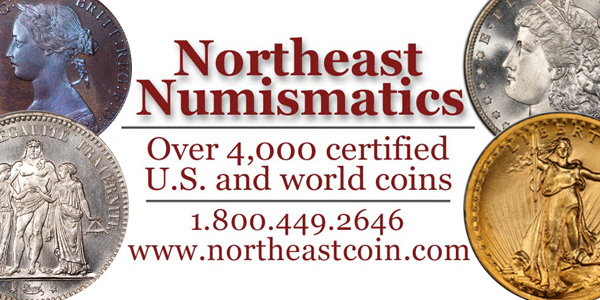
COIN WORLD REDESIGN IMPLEMENTED
The print and digital versions of Coin World have undergone a makeover. An Editorial in the August 13, 2018 issue by Managing Editor William T. Gibbs describes the changes. With permission, we're republishing it here. Thanks to Bill for sending the cover image used here. It looks nice! -Editor
 Our redesign and renewed
commitment
to additional editorial
content, begun
last issue in our August monthly,
continues this week in our
first weekly issue for the month.
Our redesign and renewed
commitment
to additional editorial
content, begun
last issue in our August monthly,
continues this week in our
first weekly issue for the month.
As with our August monthly, this weekly issue features an increased number of pages — 52, to be precise, a bump up from the 36- and 44-page issues we have been publishing recently. That extra space will be used for expanded news, features, columns, and departments.
This week, I would first like to draw attention to a new regular feature for the weekly issues, called “Coin Values Spotlight.” This new column will focus on a small number of coins, often just one or two pieces, by exploring a little bit of their history and examining how they have been doing in the marketplace over the past 10 years.
In other changes, our regular columns — staff-written ones like “Readers Ask” and freelance pieces like Q. David Bowers’ “The Joys of Collecting” and Bill O’Rourke’s “Found in Rolls,” are getting more space. This will especially be important for columns like Michael Fahey’s “Detecting Counterfeits,” John Wexler’s “Varieties Notebook” and John Roberts’ “About VAMs” columns since those authors often rely on detailed photographs to illustrate diagnostic points on the coins they are discussing.
We are also revamping Pages 14 and 15, to make our Editorial commentary more inviting, including the use of more images. The Guest Commentary and Letter to the Editor columns are your columns — please consider a submission offering your opinions or insights on the issues collectors face today. We will also share some of the best comments we receive at our Facebook page and on the articles published at our website.
The changes appearing this week are by no means the only editorial changes you will be seeing in the weeks ahead. I hope to introduce some new columns, including a regular one about tokens from around the world. And if you have a column topic you would like to see, contact me.
Let me know what you think about these changes. We are always seeking to improve what we do.
To visit the Coin World web site, see:
https://www.coinworld.com/

NEWMAN PORTAL ADDS THE VIRGINIA NUMISMATIST
The latest addition to the Newman Numismatic Portal is The Virginia Numismatist. Project Coordinator Len Augsburger provided the following report. -Editor
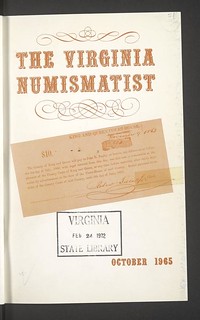 With the permission of the Virginia Numismatic Association (VNA), Newman Portal has added The Virginia Numismatist for the period 1965 to 2012. Issues were scanned at the Library of Virginia in Richmond, VA under Newman Portal sponsorship.
With the permission of the Virginia Numismatic Association (VNA), Newman Portal has added The Virginia Numismatist for the period 1965 to 2012. Issues were scanned at the Library of Virginia in Richmond, VA under Newman Portal sponsorship.
While including the usual updates on local numismatic events, the publication also presents numerous feature articles such as Richard Doty’s “Virginia Numismatics at the Smithsonian,” as found in the March 1999 issue. I also enjoyed Tom Kays’ “Digging up the First Federal Coins in Virginia” from the Summer 2003 issue.
Newman Portal recognizes Tom Kays and Dave Ellison of the VNA, and Errol Somay of the Library of Virginia for their assistance with this project.
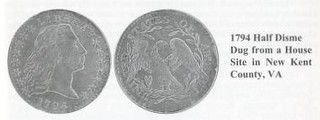
Images:
• Front cover of the October, 1965 issue of The Virginia Numismatist.
• 1794 half dime dug in Virginia, from the Summer 2003 issue.
Link to Virginia Numismatist on Newman Portal:
https://nnp.wustl.edu/library/publisherdetail/527595
MORE ON CIRCULATION/CIRCULATED CAMEO
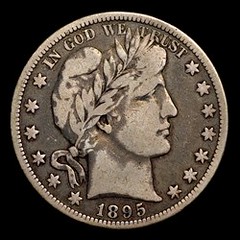
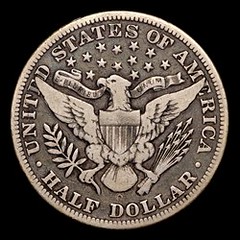
Newman Numismatic Portal Project Coordinator Len Augsburger writes:
The E-Sylum of July 22 noted the term “circulated cameo,” and several variants thereof. The earliest usage found on the Newman Portal dated to 2007, in the Chicago Coin Club Chatter, and was used in the context of circulated Barber coinage. The term is also found occasionally in the publications of the Liberty Seated Collectors Club.
There is a theme here – circulated 19th century American silver coinage is sometimes found with the “two-tone” or “circulated cameo” effect, typically darker fields contrasting with lighter devices. It’s a matter of taste, but advanced collectors tend to like them. Attached is an example from the Newman II sale (Heritage, 11/2013), lot 34619, an 1895-O Barber half dollar (realized $223.25).
Link to Chicago Coin Club Chatter (2007):
https://nnp.wustl.edu/library/book/544089?page=35
Link to Newman II image collection on Newman Portal:
https://nnp.wustl.edu/library/imagecollection/511938
I check the Newman Portal almost reflexively now, but I didn't in this case. With its vast store of pre-1923 out-of-copyright numismatic material, it's the ideal place to research the creation and evolution of numismatic terminology. While it doesn't prove the terms weren't used earlier (in some document not yet in the portal, or one where the text was OCR'd incorrectly) this does confirm that the term "Circulated Cameo" was used at least as early as 2007. Thanks! -Editor
To read the earlier E-Sylum article, see:
David McCarthy and
Bill Eckberg
submitted these thoughts on our ongoing discussions of the origin of the Continental Dollars. Thanks.
-Editor
David McCarthy writes:
The earliest reference to the existence of an object definitively identifiable as a Continental Dollar in a U.S. publication is in The American Journal of Science, published in January 1835 (Volume 27).
In it, the author (an American writing from London) describes the purchase of a Continental Dollar from British dealer Matthew Young, along with a variety of other U.S.-related pieces.
A couple other early mentions:
Olla Podrida: Or, Scraps, Numismatic, Antiquarian, and Literary, published by Richard Sainthill of Topsham, Devon (1853) describes an American leaden coin which is obviously a Continental Dollar.
Historical Magazine: And Notes and Queries (1857) published a description of the Continental Dollar (described as a coin or medal). It goes on to say that no coins were ever in circulation and that H.G. Somerby acquired in England in 1853. This coin was then given to Matthew Stickney...
To read the The American Journal of Science article, see:
American Journal of Science: The First Scientific Journal in the ..., Volume 27
On Elias Gervais
Elias Gervais would seem to be the most likely culprit in Europe – the information available about him is relatively scant. In the last year or so, I’ve read what I could and have tried to get a few of his coins in hand. Here are a few observations that may be helpful:
The Continental Dollar is hand-engraved, without letter punches (as are virtually all of the coins attributed to Gervais), so a exact match of the EG cannot be made; however, the stylistic similarities are undeniable.
Gervais habitually used line shading, as found on the Continental Dollar – this does not prove anything, but certainly establishes the fact that we ought to be looking at him carefully.
I have examined at least two of coins attributed to Gervais that have leaved edges – both had three leaves, rather than the two usually (but not always) found on Continental Dollars. Like the Continental Dollars, these edges were applied with a castaing machine, and the form of these leaves were quite similar to the ones found on the Continental Dollars.
More on the German Connection
Fascinating. In this context, it may be worth repeating that Newman and Levine published the first known report of the Continental Currency coins, which was in a German almanac published at the end of 1783.
My concern about Gervais is that he died in 1777 and the Continental Currency pieces don’t appear to have been made before 1783. My opinion on these remains consistent, but I don’t think Gervais is the smoking gun that some see him to be.
All good points. Thanks!
-Editor
Other Discussions
David McCarthy adds:
There are a couple of ongoing threads at PCGS on this topic that may be of some interest to your readers.
Hopefully, some more substantial discoveries about these pieces are yet to be made.
From my perspective, a good deal of the recent research got its start in the first thread following the publication of Catherine Eagleton’s piece in 2015. There’s a lot to wade through, but it’s fun to see the collaborative nature of the thing.
Continental Dollar Struck in Europe - NN Article...
(https://forums.collectors.com/discussion/946694/continental-dollar-struck-in-europe-nn-article/p1)
Now that research indicates Continental Dollars are not of American origin...
(https://forums.collectors.com/discussion/1002274/now-that-research-indicates-continental-dollars-are-not-of-american-origin/p1)
To read the earlier E-Sylum article, see:
David Lange submitted these notes about The Flying Eaglet
-Editor
I finally had a chance to go through those issues of The Flying Eaglet that I bought during the American Numismatic Association's book sale in Colorado Springs.
The April 3, 1959 edition includes a story about Editor Frank Spadone being summoned to a radio station in the wee hours of the night to meet with Walter Breen, who had a specimen of the 1943 bronze cent with him and was a guest on a radio show called Big Joe's Happiness Exchange. This show is mentioned frequently in TFE, as its host evidently was a coin enthusiast and featured the hobby in his broadcasts.
I'm attaching scans that show Spadone with a couple of radio staffers, as well as a great shot of him with a youthful Breen, who is unrecognizable without his beard.
Interesting. Thanks! The 1943 bronze cent was probably the Don Lutes discovery specimen Breen wrote about in the circa 1959 postcard discussed two weeks ago.
-Editor
To read the earlier E-Sylum article, see:
David T. Alexander submitted these recollections about Walter Breen.
-Editor
My review went into the system and soon returned attached to Vice President Dan Francis, who pointed out forcefully "Walter Breen does not exist at Coin World! Walter Breen will never exist at Coin World!!! Rewrite this, and
delete any mention of Breen!"
Realizing that I'd stepped in it, I quietly checked with senior writer the late Jay P. Guren, who filled me in. Years
before, Breen had written a column, "Bristles and Barbs," filled with deep "inside stuff" about great America rarities. The controversial Breen employed many old vocabulary terms including Piece de Plaisir, Piece de Fantasie that were familiar to old-time collectors, plus a new one, PIECE DE MERDE!
The first two terms described coins made long ago for rich collectors: Piece of Pleasure, Piece of Fantasy. The third was Breen's own addition, PIECE OF S--T. Here was a Frenchified usage he knew would slide past Western Ohio proof readers, and it did. Publisher J. Oliver Amos returned from vacation, and Guren mischievously brought the new term to Oliver's
attention and Breen was driven from the Garden with a fiery sword!
Several years later, Stanley Apfelbaum, self-described father of telemarketing, bought Breen and began advertising him to the hilt, flying out with his lawyers to tell Oliver how it was going to be: "I own this man and I'm spending unlimited money on ads publicizing him. If he doesn't appear in our Coin World ads, I'm going to sue you into infinity!!!" Breen now saturated Coin World in First Coinvestors ads!
At the 1980 ANA Convention in Cincinnati, I was joined by my wife Pat and stepson Robert. Pat napped and Robert joined me for the reception hosted by the Mexican gold coin marketing eight stories down. Our elevator opened at lobby level, filled with the broiling summer sun and there stood Breen in his flip-flops, unwashed rumpled shorts, squalid tie-die shirt, nodding off on his feet.
My stepson goggled as Breen opened his eyes and came awake
like some kind of Disney monster, leering at the lad "Hi IIIII!!!!" Never a diplomat, 14 year-old Robert looked up at me and loudly demanded, "What's THAT!!?? Santa Claus in drag?? Ah, well, long ago.
To read earlier E-Sylum articles, see:
Bob Van Arsdell submitted these thoughts on the book cutting David Pickup is hoping to identify. Thanks!
-Editor
It’s definitely not the 1793 3rd edition of Stephen Martin Leake’s An Historical Account of English Money. The plate images are different.
My copy of Leake’s 1726 1st edition (anonymous but with the usual ”Printed for W. Meadow at the Angel in Cornhill”) is missing several of the plates. Some of the 1st edition plates are the same as appear in the 3rd edition. Others were re-engraved for use in the 3rd edition and still others were completely re-done for the 3rd edition. However, all are similar in style/format.
Beyond this, the obverse/reverse images either touch or overlap slightly (obverse image on top) in both editions. On the handful of coins that have a connecting bar, it’s a very short one made up of two lines.
The likely plate for the Portcullis type coin is missing in my Leake 1st edition, but would probably not have included such an elaborate title.
Taking all this into account, I doubt that the 2nd edition of Leake would have had the image, but I’ve never actually SEEN a copy of the second.
The image isn’t from Thomas Snelling’s 1769 Miscellaneous Views of the Coins Struck by the English Princes in France, Counterfeit Sterlings, Coins struck by the East India Company, etc..... The one in Snelling is very different.
Initially, Snelling was my first suspicion.
So....we’ve got something of a tricky one here. The coin was well-known by the 18th Century, so it didn’t warrant the elaborate title if was included in a plate of many coins in a numismatic work.
It’s also not from Bishop Fleetwood’s Chronicon Preciosum 1745, the image is different
Nor is it from Evelyn’s Numismata 1697, in which an East India coin is mentioned but not illustrated.
By the 19th century, the style of coin illustration in Britain changed, so the cut’s unlikely to be that late.
My guess is that it could be an in-line plate in a page of text. It’s possible the book may not have been a numismatic one.
Of course, another reader will know exactly from which book the plate has been cut - rendering my guess immaterial.
To read the complete article, see:
Reader Becomes Member
I wanted to let you know how much I enjoy The E-Sylum. It is ALWAYS a great read, and it actually inspired me to join NBS. I've made some great additions to my library based upon articles in The E-Sylum and The Asylum, and I am putting up an exhibit at the ANA next month which itself was directly inspired by what I've learned through my membership in NBS, and it includes some of the books I've acquired due to E-Sylum and The Asylum. So thank you for all that.
Glad to help! Welcome to NBS.
-Editor
On the Value of Washington Inaugural Buttons
Also, the value quoted of $7500 each is ridiculous. I presently have a beautiful example for sale at under $5000. The value of an average "nice" condition dug piece is more like $1500.
Finally, the comment that one of these buttons would cost six months salary for an average person back in 1789 is patently silly. An unskilled laborer averaged around 40 cents a day, say $125-150 a year. Skilled labor and artisans made double that amount, and teachers were in the range of $400 a year. While I don't know the cost of one of these buttons at the time, I would guess that they were no more than a dollar or two.
I don't follow the market for these, but the other two items stuck out for me, too. Only if the Dept. of the Interior in turn contacted a knowledgeable dealer would they be able to provide a meaningful answer, and a year's salary for a button is crazy. I don't know where they got that from. Articles on numismatic items in general newspapers almost always manage to mangle the facts, but they're still great for helping to spread interest in numismatics.
-Editor
Alan Weinberg adds:
I agree totally with Rex's comments on the value of these GW Inaugural buttons. They are actually quite common with multi-hundreds known.
They often come up for sale or auction.
There are also highly deceptive spark erosion-produced forgeries known. Even the experts can be momentarily fooled. I was one.
To read the earlier E-Sylum article, see:
Answer: San Francisco Committee of Vigilance Medal
Regarding the piece a Newman Numismatic Portal user asked about,
Rex Stark writes:
Alan Weinberg and I discussed the engraved San Francisco Vigilance Committee medal, and we both agree that it's a worthless fantasy.
Bill Hyder writes:
The Vigilance Committee issued membership certificates in 1851, but no medals. The engraved 1851 medals are fantasies and have been around for some time now. Engraved gold medals were made for San Francisco alderman and one of these is on the Newman site. Michael Wehner (an avid collector of the 1856 medals) and I have an article slated for the December issue of The Numismatist that deals in part with the Committee of Vigilance medal and an 1861 Civil War political medal issued in San Francisco.
Thanks, everyone. Here's the gold medal Bill mentioned. It's a "City of San Francisco to Morgan L Mott, Alderman - Gold Nugget Medal" from the Alan Weinberg collection.
-Editor
To view the medal images on the Newman Numismatic Portal, see:
To read the earlier E-Sylum article, see:
The John S. Davenport Library
Reports on the demise of the John S. Davenport library have been greatly exaggerated. While some of his books kept in an outside storage shed did perish, many others survived in excellent condition and were sold in Kolbe Sale 87, March 22, 2002. Comprising lots 767 to 1070, the consignment was billed as “The John S. Davenport Library & Numismatic Research Archives.” Many featured Dr. Davenport’s bookplate and a number were inscribed to him and/or were signed by him.
Highlights included a set of Brause-Mansfeld’s classic work on siege coins; Lyman Low’s interleaved and annotated 1878 Fonrobert collection catalogue of South American coins and medals; Madai’s famous 1765–1774 “Thaler Cabinet”; a set of Tentzel on “Saxonia Numismatica”; and numerous other 18th and 19th century classics. Over two dozen numismatic publications written by and belonging to Davenport were featured in the library. A number were interleaved, many were extra-illustrated by Davenport, and a goodly number were greatly enhanced by his annotations.
Additionally, Davenport’s photographic archives were sold as a single lot, comprised of “tens of thousands” of illustrations of European crowns and talers, and various other world coins.
Thanks. Libraries and collections evolve over time, changed constantly by acquisition and deacquisition. A snapshot in time rarely shows the complete picture. Do any of our readers own books with the Davenport Library bookplate?
The lesson remains, though - Florida storage sheds without cooling or dehumidification are less than ideal homes for books.
-Editor
George Kolbe adds:
In that vein, years ago I traveled to Tampa, Florida, to buy a library potentially worth tens of thousands of dollars. I bought barely enough to pay for the trip, and a number of the books I purchased only marginally passed the smell test. Most of the books had been subjected to extreme heat, humidity, and insects. It was depressing to see wonderful classic numismatic works mouldering away.
In contrast, when I purchased the library of Thomas Faistauer in Cambuquira, Brazil, the books were kept in his temperature and humidity controlled home and were generally in excellent condition.
The San Bernardino Mountains may be a bit off the beaten path but Crestline is an extremely good place for books.
To read earlier E-Sylum articles, see:
The Corio Gold Stater
Last week this Corio Gold Stater from Baldwin's caught my eye.
-Editor
Bob Van Arsdell writes:
I’ve written a dozen articles about the Semiotics of Celtic Coins in Britain. Several of the articles talk specifically about the Dobunnic emblem.
It’s too easy to look at the abstract images and see anything you want to see - like looking at clouds and seeing bunnies.
Celtic coins, as any others, carry crafted messages from rulers to the people. Expect complexity - the subject of interpretation requires an approach to match.
All the articles are on my website (Homepage/Numismatic Articles on the vertical Navbar). They can also be found in the list of Semiotics articles in the catalog (Background/Semiotics on the horizontal Navbar).
Although the articles are tailored to the British Celtic series, the underpinnings lie in the work of Umberto Eco. The principles involved are applicable to any kind of numismatic imagery.
The Bibliography, now over 125 pages long, can be found in the catalog under (Appendices/Bibliography on the horizontal Navbar). It includes much of what has been written on the subject of British Celtic numismatics
Thanks!
-Editor
To visit Bob's web site, see:
To read the earlier E-Sylum article, see:
The 1806 O-108 Half Dollar
It was a treat to again see the 1806 O-108 half dollar
in The E-Sylum. I was delighted when it came across my desk for attribution and grading by NGC, and I had it photographed prior to encapsulation. This rare coin is now a star at NGC's VarietyPlus website.
1806 KNOB 6 NO STEM O-108 50C MS
Diagnostics
Comments
Naturally, I like the un-slabed photos better. Thanks!
-Editor
To view the coin on VarietyPlus, see:
To read the earlier E-Sylum article, see:
Morgan Dollars and Mint Display Boxes
I have some of the Morgans housed in mint boxes, I will dig up some info. My recollection is the coins were on display at the Old San Francisco Mint, and when the display came down they sold the coins. There were a few hundred of them. The mint sent letters to some subscribers to see if they wanted them. I think this was in the mid-1990’s.
Interesting provenance if that connection can be documented. It doesn't mean the coins are particularly rare or special, but it's a good story. Why have a run-of-the-mill coin when you can have one that once was part of an exhibit? But without today's coin encapsulation there's no way to prove a boxed coin came from that source.
Gene Brandenburg's piece was purchased at a Mint store in Washington, D.C., but it could have been supplied from San Francisco.
-Editor
To read the earlier E-Sylum articles, see:
The Dunsmore Painting Mint Bicentennial Medal
I like the description of the John Ward Dunsmore "Washington Inspecting" painting: "As history, however, the painting is pure bunk, depicting, as it does, a group of people who mostly never visited the Mint, attending a ceremony that never occurred, all set in a Mint building that did not
exist in 1792." This historical inaccuracy didn't seem to bother the Mint too much as they used that work on the U.S. Mint Bicentennial Medal issued in 1992. I recently sold an example of this medal on eBay still in the sealed plastic protection; stuffed in the box of issue was the
Mint press release concerning this medal.
Thanks. This arrived from Dick back on July 10, but got buried in my inbox for a while. Sorry.
-Editor
To read the earlier E-Sylum article, see:
United States Agricultural Society History
I poked around, and learned that the Society was indeed quite influential. There is a 1937 Agricultural History article titled, The United States Agricultural Society, 1852-1860: Its Relation to the Origin of the United States Department of Agriculture and the Land Grant Colleges.
Wikipedia has some information, too.
-Editor
From Wikipedia:
The United States Agricultural Society was founded during a convention. Twelve different states in the country had agricultural societies. They decided to become one unit, creating the USAS. It was the started at time when there was no Department of Agriculture in the United States government, before Abraham Lincoln established an independent Department of Agriculture...
The Society held its annual meeting in Washington DC and held exhibitions in other cities in the United States. It was powerful body with the ability to influence Congress and was able to influence the Congress to bring in enactments the Land Grants Act and creation of Department of Agriculture in 1862 can be attributed to it.
To read the Wikipedia article, see:
United States Agricultural Society
(https://en.wikipedia.org/wiki/United_States_Agricultural_Society)
For more on the Agricultural History article, see:
The United States Agricultural Society, 1852-1860: Its Relation to the Origin of the United States Department of Agriculture and the Land Grant Colleges
(https://www.jstor.org/stable/3739485?seq=1#page_scan_tab_contents)
To read the earlier E-Sylum article, see:
Flavors of the U.S. Mint
Dick Johnson forwarded this Family Circus cartoon by U.S. Mail, and I scanned it for use here. Thanks.
-Editor
Eric Mead's Amazing Coin Magic Trick
Tom Fort submitted this great coin trick video. Thanks!
-Editor
Eric Mead performs an amazing coin magic trick on Penn & Teller Fool Us. Does it fool them? I hope you enjoyed this great performance.
Tom adds:
I am not certain if one wants this magician coming into a coin show. Dealer stock could disappear and the crowd would love it:
To read the earlier E-Sylum article, see:
Last week Gerald Tebben asked about PNG Authentication Certificates.
-Editor
Michael T. Shutterly writes:
In last week's E-Sylum you asked if anyone had a PNG Authentication Certificate they could scan. I have one and have scanned it.
The original document is legal size. It's a two-sided document, the "certification" stuff is on the front side, the back side consists of the legal folderol.
Thanks! The address and other information are obsolete, and Michael is OK with publishing this. He will also offer it to the Newman Numismatic Portal to preserve for posterity. Their digitization equipment would do a better job - he had to make do with his letter-size scanner.
-Editor
I noticed that at the top right (under the serial number) it says "(THIRD SERIES)". So I suppose new versions were printed as the form and its legal verbiage evolved. So more versions of these may be out there to be found. Does anyone have a different one to report?
-Editor
To read the earlier E-Sylum article, see:
David Gladfelter writes:
I thought I might have a pre-slab PNG authentication certificate to scan for you but no luck. However, I did find these old “Numis-Mailrs”. Kept them just in case I needed to safely mail coins or tokens. The dealers could put their own ads on them. Will send you a separate scan of the inside showing the 2x2 size pockets.
Thanks! I'd never seen these before. Great numismatic ephemera!
-Editor
To read the earlier E-Sylum article, see:
The large diameter of the Cyrus Field Congressional Medal (PE-10) allows for numerous lines of lettering in three styles in its reverse design. The legend at the top is in a double bowed base line. The line of lettering above the exergue symbols is a bowed up base line. There is an undulating base line in the center of the medal. All other lines have horizontal base lines. All these terms are necessary in making an accurate numismatic description in cataloging this medal.
Base Line.
An imaginary line indicating the plane for all lettering on a numismatic or medallic design. This appears mostly in a straight line for all inscriptional wording, or in an arc (BOWED lettering) for those in the LEGEND. Infrequently an UNDULATING BASE LINE will be used for lettering appearing in a wave for artistic effect, or too long an inscription to fit the space. An example of several kinds of base lines (undulating, bowed, and straight) appear on the reverse of the City College of New York Medal of 1866 (Julian CM-14), and on the reverse of the Cyrus West Field Congressional Medallion, 1868 (Julian PE-10), both struck by the United States Mint.
Also a horizontal line forming the base of a medallic design, often separating the device from the EXERGUE. The base line is important in determining the horizontal orientation of the design; features like horizon, water line, base of buildings are parallel to this, as is INSCRIPTION lettering. Flag poles, sides of buildings and other vertical lines are, of course, perpendicular to the base line in a linear perspective of the design. Compare listel, register, ground line.
Compare LISTEL, REGISTER, GROUND LINE.
Lettering without use of a base line, or staggered base line exist but are rare. An example is the letting on the obverse of the W.H. Nicholas Medal (issued by the New York Chapter of the American Chemical Society). It was designed by Henry M. Toch who placed the letters in the chemical fumes emanating from heating a retort (from H.B. Wechsler’s painting, Alchemist).
REFERENCE:
Bowed.
Lettering in an arc. Such lettering usually follows the contour of the item with a base line that is congruent with the edge; however bowed lettering can appear anywhere on the numismatic piece. All LEGEND on a numismatic piece is bowed. See BASE LINE.
Undulating Base Line.
A line of lettering appearing in a wave for artistic effect. This usually is a result of extra long lettering to appear on the item. This is particularly a problem for smaller items, like medalets. The heraldic term for this design element is undé. A Grant Medalet of 1868 (Julian PR-42) with four lines on the reverse has the wording “Commander in Chief” undulating but is most dramatic on a large medal (as Julian PE-10). BASE LINE.
References:
Looking for the meaning of a numismatic word, or the description of a term? Try the Newman Numismatic Portal's Numismatic Dictionary at:
https://nnp.wustl.edu/library/dictionary
Or if you would like a printed copy of the complete Encyclopedia, it is available.
There are 1,854 terms, on 678 pages, in The Encyclopedia of Coin and Medal Technology. Even running two a week would require more than 19 years to publish them all.
If you would like an advance draft of this vital reference work it may be obtained from the author for your check of $50 sent postpaid. Dick Johnson, 139 Thompson Drive, Torrington, CT 06790.
William Frederick Fratcher (1867-1947) was born on November 18, 1867 at Utica, Oneida County, New York, son of David W. Fratcher (1845-), and Mary Weidle Fratcher (1846-).
He appears to have been a stamp collector from his youth.
About 1884, he moved to Detroit, Wayne County, Michigan
He married Luella Maude Jackson (1869-1937). They had a son Vernon Claude Fratcher (1890-1964). They lived on Seventh Street, Detroit, Michigan.
He is listed in the 1896 Detroit City Directory as a Confectioner located at 344 Michigan Avenue, Detroit, Michigan. These 19th century confectionery shops typically sold newspapers and tobacco.
Fratcher advertised in the April 1909 issue of Popular Mechanics, selling old coins selling an Illustrated Buying List for 10 cents.
In 1915, his confectionery, cigar and ice cream shop expanded to include a stamp and coin shop at 256 Michigan Avenue, Detroit called Michigan Stamp & Coin Company.
In 1925, he is listed as an ANA Member 2780 living at 912 Michigan Street, Detroit, Michigan.
Fratcher was also a member of the Detroit Coin Club in the 1920's.
In August 1936 he appears to be assembling a complete set of The Numismatist since he is advertising to purchase volumes he is lacking.
He died on December 2, 1947. A notice was published by the Detroit Coin Club in their minutes published in the January 1948 issue of The Numismatist on page 69.
To read the complete article, see:
The entire inventory of the Lupia Numismatic Library is for sale. Individual items will be available before the remaining archives are broken up into parcels sold at philatelic auctions in the U. S. and Hong Kong. Check
NumismaticMall.com frequently as dozens of new items with estimates will be posted daily until everything is sold.
All inquiries will be given prompt and courteous attention. Write to:
john@numismaticmall.com
.
To further acknowledge Eric Newman’s contributions to their Summer Seminar program, the ANS has renamed the Scholar’s title in his honor.
-Editor
Ute Wartenberg Kagan, Peter van Alfen and students present the Eric P. Newman medal to Prof. Mariangela Puglisis (center).
American Numismatic Society announces gift from Eric P. Newman
Numismatic Education Society
For over sixty years the American Numismatic Society (ANS) has offered an intense eight
week long summer course in numismatics to select graduate students. Always interested in numismatic education, Eric P. Newman’s generous lifetime endowment of the ANS’s Summer
Seminar has allowed the ANS to continue to train new generations of numismatists. Following Mr. Newman’s passing in November 2017 at 106 years of age, the ANS received word that
per his request the Eric P. Newman Numismatic Education Society was donating an additional $50,000 to the Seminar’s endowment fund to be used to enhance the stipend of the Visiting
Scholar, always a renowned numismatic scholar invited to assist in teaching the Seminar.
To further acknowledge Mr. Newman’s contributions to the ANS’s premiere educational program, the ANS has renamed the Scholar’s title in his honor. The first Eric P. Newman Visiting Scholar is Prof. Mariangela Puglisi of the University of Messina in Sicily, who is also the first recipient of the Newman Visiting Scholar medal. The presentation of the medal to Prof. Puglisi took place during a special ceremony at the ANS on July 27, 2018. Executive Director Ute Wartenberg remarked, “We are so grateful to Eric’s children, Andy Newman and Linda N. Schapiro, for their continued generosity for the Summer Seminar and numismatics in general.”
For more information on the Eric P. Newman Graduate Seminar in Numismatics, see:
This press release announces the American Numismatic Association's highest honor awards for 2018. Congratulations to all!
-Editor
The American Numismatic Association (ANA) is recognizing several numismatists who not only lead by example, but pave new pathways within the numismatic hobby. Recognized for their dedication, hard work, passion and contributions, these recipients will be recognized at the World’s Fair of Money in Philadelphia, Aug. 14-18.
Those being recognized are:
Cindy Wibker for the Farran Zerbe Memorial Award for Distinguished Service
Farran Zerbe Memorial Award
For 25 years, Wibker has dedicated her career to Florida United Numismatists (FUN) as convention coordinator, organizing one of the premier shows in the country. This is no easy task, as FUN’s annual January show regularly draws an average of 10,000 attendees over four days, and its summer event, held each July, welcomes about 3,000 hobbyists.
Born in Shreveport, Louisiana, the young Wibker enjoyed filling Whitman nickel and cent folders with pocket change and acquiring specimens through mail-order businesses. However, her mind turned to other pursuits. Growing up she enjoyed spending time outside playing different sports, going to games, spending time with her family and riding her bike.
During her last year of college, she returned to numismatics. Wibker’s then-husband, Bob Grellman, who began collecting at age 7, encouraged her to once again dip her toe in the numismatic waters. She bought her first Civil War token in April 1975 and was hooked.
An Air Force wife for 13 1/2 years, Wibker took time off from her career to raise her two sons, Kevin and Andrew. During this period, she acquired more Civil War tokens, as well as Thomas Edison medals, early Mardi Gras collectibles and Louisiana tokens. Unlike her childhood self, Wibker learned to love history as an adult, mostly through the lens of Civil War tokens.
In 1988, after her husband retired from the Air Force, Wibker and her family moved to Florida. Jim Partin, a friendly face in the hobby, encouraged the busy mom to run for the FUN board. She was appointed exhibit chairman in 1990 and was on the board for three years. When the convention coordinator suddenly passed away, Wibker was asked if she would like to give the position a try. She took on the challenge, taught herself how to do the job and has been a success at it for 25 years.
Among her numerous honors are the Award of Merit (2005), Presidential Award (2007) and Polly Abbott Service Award (2011) from FUN; and Woman of the Year (2001 and 2009) from the National Silver Dollar Roundtable. She was named a Numismatic Ambassador by Numismatic News in 1994. In addition to FUN, she has served on the board of directors for the Civil War Token Society, Token and Medal Society and Women in Numismatics, of which she is a charter member.
Wibker joined the ANA in 1980. She was quickly recognized for her numismatic knowledge and people skills, and got to know many individuals in the hobby. At age 25, she tried her hand at exhibiting and was surprised when her Alabama coal-mine tokens display won best of show. She went on to become an exhibit judge in 1987.
Wibker’s steady involvement with the Association brought her many accolades, including the Glenn Smedley Memorial Award (1996) and ANA Medal of Merit (1997), Exemplary Service Award (2002), three Presidential Awards (1997, 1998 and 2009) and the Joseph E. Boling Award for Judging Excellence (2010). In 2017 she received the ANA Goodfellow Award in recognition of her work as host chair of the ANA’s National Money Show® in Orlando.
Numismatist of the Year
Having a lifelong interest in numismatics, he accepted a position with Richard Nachbar Rare Coins in 2000. In 2003 he moved to Northern California to continue his career with Kagin’s, where he is currently the firm’s senior numismatist and researcher.
McCarthy has been a consultant to the Smithsonian Institution, the United States Secret Service, Bank of California, Union Bank, The San Francisco Old Mint and the American Numismatic Association. He is a contributor to A Guide Book of United States Coins (the “Red Book”) and CoinWorld, and has published groundbreaking research in The Numismatist. His article “Nova Constellatio: Identifying the First American Coin” (August 2017) received a Wayte and Olga Raymond Memorial Literary Award.
An ANA life member, McCarthy also belongs to the Florida United Numismatists, Pacific Coast Numismatic Society and Central States Numismatic Society. He received the ANA’s Glenn Smedley Memorial Award in 2015.
McCarthy enjoys sharing his expertise and enthusiasm for numismatics and has taught several classes at the ANA’s Summer Seminar. He also is a sought-after speaker on the subject of pioneer gold coins, regulated gold of Early America and other specialized areas of numismatics, history and collecting. He is particularly knowledgeable about the coinage of Julius Popper, Massachusetts silver and American Confederation gold.
Young Numismatist of the Year
In 2012, Zechman was moving up the ranks in Girl Scouts. That year, she entered a Florida United Numismatists (FUN) show looking to earn a coin-collecting patch and left with a passion for numismatics.
She quickly joined FUN and has since become a member of Early American Coppers, the Combined Organization of Numismatic Error Collectors of America (CONECA) and the Original Hobo Nickel Society. Coin carving came naturally to the art-minded student, who has taken numerous classes and explored a variety of media. She counts the late Archie Taylor, well known for his carved creations, among her most cherished mentors.
The 16-year-old collector attended ANA's Summer Seminar this year and served as auction head for the YN Benefit Auction during the second week. After graduating high school, Zechman intends to pursue a career as a coin grader and welcomes the opportunity to help others.
Lifetime Achievement Award
An avid American Numismatic Association promoter, Lighterman has been a national volunteer since 2003, taking on his current duties as national exhibit coordinator in 2008. He chaired the ANA Exhibiting Committee from 2005 to 2009, and today also serves the ANA as parliamentarian. Lighterman is president of Combined Organizations of Numismatic Error Collectors of America (CONECA), treasurer of the Token and Medal Society (TAMS), past president of Florida United Numismatists (FUN), and a charter member of the Casino Chip and Gaming Token Collectors Club. He has written articles for The Numismatist and CONECA’s bimonthly publication, ErrorScope.
Lighterman is always looking for new Florida gaming tokens to add to his collection, and he avidly pursues error coins. Among his many major off-metal strikes are a $20 gold piece struck on a large cent, a Flying Eagle cent struck on a half dime, and a 1934 Peace dollar struck on a quarter. Although the latter is one of his favorites, he quickly notes that all his coins are important to him. Several years ago, Whitman Publishing sought him out for his expertise, and in 2010 he contributed to Nicholas P. Brown’s 100 Greatest U.S. Error Coins.
In 2009 Lighterman took his place alongside fellow hobbyists in the Casino Chip and Gaming Token Collectors Club’s Hall of Fame. He was recognized as CONECA’s Lyndon King Outstanding Member of the Year in 2012 and inducted into the organization’s Hall of Fame in 2014. The ANA presented him its Presidential Award in 1999, the Glenn Smedley Memorial Award in 2002, Medal of Merit in 2012, Adna G. Wilde Jr. Award for Excellence in 2015, and Farran Zerbe Memorial Award for Distinguished Service in 2016.
Pat McBride of the Pennsylvania Association of Numismatists (PAN) is coordinating volunteers for the upcoming American Numismatic Association World's Fair of Money (WFOM) in Philadelphia.
Most show volunteers will wear a colorful shirt and many will also sport a button honoring the host city. Nicely done!
-Editor
Pat writes:
The volunteer shirts have been ordered and they are a gold/yellow color. It was decided that they are bright and easy to spot. I made up a 2.5" button that works in the Philadelphia Eagles team colors and plays up the eagle. I used the eagle from one of the 1804 dollars.
I think it is a nice recognition of the host city.
We'll also have them as pass outs at our PAN Table, Club Midway #246
These may one day become scarce and sought-after items of ANA show ephemera, so stop by the table, say hello, and get one while supplies last.
-Editor
For more information on the 2018 ANA World's Fair of Money, see:
One of the legendary 1787 gold Brasher Doubloons and seven of the finest known 1780s New York colonial era copper coins will be displayed together for the first time in an educational exhibit hosted by Professional Coin Grading Service (www.PCGS.com) at the American Numismatic Association 2018 Philadelphia World’s Fair of Money®, August 14-18.
“The lettering and some design elements of all seven of these distinguished coins are punch linked, and each of these coins is an important part of early American history and numismatics. They will be exhibited at the PCGS booth, #1431, during the 2018 ANA convention,” said PCGS President Don Willis.
The Brasher Doubloons are the first gold coins made in the United States proposed or intended for circulation. The design includes the obverse motto, NOVA EBORACA COLUMBIA EXCELSIOR (translated as "New York and America ever upward”).
The coin’s creator, Ephraim Brasher, was well known at the time as a silver and goldsmith and civic leader in New York City, and later was a neighbor of George Washington in lower Manhattan.
Only seven Brasher Doubloons are known; six with the designer’s “EB” hallmark on the eagle’s wing, one with it on the eagle’s breast. The coin that will be displayed in Philadelphia has the hallmark on the eagle’s right wing, and it is the discovery specimen for Brasher Doubloons that was first documented in 1840.
This famous coin was exhibited at the 1964 New York World’s Fair, was a featured display in a nationwide touring exhibit for the 1987 bicentennial of the United States Constitution and was displayed at the Epcot theme park at Walt Disney World in 1988.
The anonymous current owner of the Brasher Doubloon is described by PCGS as a “West Coast collector,” and the owner of the New York copper coins is described as “a New York dealer and collector.”
The seven New York copper pieces are all either the finest known or among the finest known of their kind. All have impressive pedigrees to one or more collections of well-known numismatists of the past, such as Parmelee, Stickney, Boyd, Garrett, Ford and/or Newman. The coins are:
• 1786 Small Head Non Vi Virtute Vici (“Not by force, but by virtue we have won”) with a portrait believed to be George Washington. Less than two dozen examples are known.
• 1787 Excelsior, Eagle facing left. This is the only Mint State example known and was formerly in the famous Garrett Collection.
• 1787 George Clinton cent, with New York coat of arms, less than a dozen known.
• 1787 Excelsior, Standing Indian/New York arms, one of only about 12 known.
• 1787 Excelsior, Standing Indian/Eagle on Globe design, one of the finest of only about 14 known.
• 1787 Nova Eborac (“New York”), rare Large Head variety, one of the finest of only a few dozen known.
• 1787 Nova Eborac, Small Head variety, less than a dozen known and closely linked to the Brasher Doubloons. This is the finest certified example and was formerly in the C.I. Bushnell and Eric P. Newman collections.
“PCGS is proud to work with the owners of these impressive, early American rare coins so visitors to the ANA convention can see and enjoy them in person,” said Willis.
John Frost submitted this information on two great exhibits planned for the upcoming American Numismatic Association show in Philadelphia. We'll be looking forward to seeing these!
-Editor
The Liberty Seated Collectors Club (LSCC) and the Barber Coin Collectors’ Society (BCCS) will have a
massive exhibition at the ANA World’s Fair of Money in Philadelphia. The groundbreaking 12-case exhibit is
highlighted by newly-discovered historic artifacts on loan from the descendants of William and Charles
Barber, the 5th and 6th Chief Engravers of the U.S. Mint. The exhibit will be in the Club Midway at booths
#146 and #148, near the rear right corner of the bourse floor.
The theme of the Liberty Seated Collectors Club exhibit is “William Barber Revealed” which sheds new
light on the work and talent of one of the least understood engravers in U.S. History. The designer of the
Trade Dollar and the Double Dime (twenty-cent piece) is often underappreciated for his accomplishments
and artistry.
The newly found artifacts show that William, despite some issues with former Mint Director H.R. Linderman,
was actually very well-liked by his peers at the Philadelphia Mint, and much appreciated for both his coin
design and medallic work. Items on display for the Liberty Seated Collectors Club include:
• Original (not a copy) Presidential proclamation naming William Barber Engraver of the U.S. Mint,
signed by Pres. Andrew Johnson and Secretary of State William Seward
• Paintings of William Barber and wife Anna Maria Barber
• Medal of William Barber (by Charles E. Barber following William’s death in 1879), from the Charles
E. Barber medal collection
• 3 original pencil/pen coin design sketches by William Barber
• William Barber medals: Centennial Medal, Grant 2nd Inaugural medal
• Scan of letter written by William Barber about Carson City dies, June 1875
• Original memo by mint officials, Sept. 2, 1879, regarding the death of William Barber
• Set of Trade Dollars
• Set of Double Dimes, including one of William Barber’s patterns and 1875-S Branch Mint Proof
• Medallic History of the United States of America – 1776-1876, 1st Edition, by J.F. Loubat, 1878, inscribed
with compliments to William Barber by the author, April 1878
• A Visit to the Cabinet of the United States Mint at Philadelphia, by Elizabeth B. Johnston, 1876, inscribed to
William Barber by the author
• And more!
The theme of the Barber Coin Collectors’ Society exhibit is “The Charles Barber you didn’t know”
featuring many new artifacts that put Charles Barber in a completely new light. Often presumed by many to
(without any evidence) be a disagreeable and difficult person, new research demonstrates quite the opposite.
Charles Barber was first and foremost a family man, who was revered by his descendants. Despite
professional rivalries, he worked collaboratively with many artists and engravers over his 48 years at the U.S.
Mint, and contrary to popular (unfounded) belief, had a friendly relationship with George T. Morgan. Even a
warm personal relationship with President Theodore Roosevelt is revealed, with the entrusting of a treasured
personal heirloom to Charles Barber. Charles was most meticulous in ensuring the process of minting coins
was efficient and produced a quality product. He was afforded the high honor of being the last U.S. Mint
official to have the flags lowered to half-mast after his death in 1917.
Items on exhibit at the Barber Coin Collectors’ Society table include:
• Painting of Charles E. Barber
• Six new photos of Charles Barber
• New photo of Charles Barber and George Morgan in Bridgeton New Jersey, March 1897
• Three patterns by Charles Barber
• Key date Liberty Head “Barber” coins (5c, 10c, 25c, 50c)
• Other coins designed by Charles Barber, including commemoratives, 1883 Hawaiian coinage, Cuban
coinage
• 1905 passport
• Memos from mint departments for European trip of 1905
• Diary of Edith Barber (accompanied her father to Europe in 1905)
• Rare heirloom 39-star Flag presented to Charles Barber by President Theodore Roosevelt
• 1906 U.S. Mint Assay medal, original case, subject: Theodore Roosevelt, from the Charles E. Barber
collection of medals
• Letter to Charles Barber from Augustus St. Gaudens, April 1894
• Letter to Charles Barber from Victor D. Brenner, January 1909
• United States Pattern, Trial, and Experimental Pieces, by Edgar H. Adams and William H Woodin, 1913,
inscribed compliments to Charles E. Barber by William Woodin, April 3, 1913
• Scan of letter from Mint Director requesting permission to lower the flags to half-staff, 1917
• And more!
In addition, at least one of the descendants is planning to be at the Annual Meeting of the Barber Coin
Collectors’ Society (Wednesday August 15, 9:00 a.m. in Room 120-C), and the Annual Meeting of the Liberty
Seated Collectors Club (Thursday August 16, 9:00 a.m. in Room 120-C). Everyone is welcome.
In addition, on Friday August 17 at 4:00 p.m., there will be an ANA Money Talks presentation entitled, Fascinating New Discoveries Regarding Father-Son Mint Engravers William and Charles Barber, in Room 121-B.
Numismatics is not just a hobby for adults. The future of the hobby is dependent on younger audiences becoming interested in collecting. Through programs like Coins for A’s and the new Adopt-A-School program, the American Numismatic Association is reaching school-age kids to promote curiosity and interest in numismatics.
The Adopt-A-School program consists of educational kits to be used in a classroom setting. Parents, district representatives or club members can “adopt-a-school” and use the kit to teach students about the importance of numismatics while adhering to the educational curriculum. Various lessons included in the kit are geared towards different age groups, from upper elementary grades to high school.
“Lots of adults end up using a ‘show and tell’ approach in their numismatic presentations at schools,” said Rod Gillis, education director of the ANA. “However, it is best to put a lesson together based on the teacher’s needs. The education kit provides the lesson plans that could easily fit into a classroom schedule, meet a teacher’s goals and provide a more in-depth look at numismatics for the kids. The youth are the future of the hobby.”
Each kit includes instructions to all the different lesson plans, a flash drive with presentations, pencils, coins needed with the lessons, reference books, worksheets, plans for an archaeological dig and more. The kit gives the user access to everything needed to successfully run the educational courses.
Adopt-A-School kits are available for free to ANA member clubs – one kit per ANA club upon request. The kits can also be purchased for $24.95, postage paid. For more information or to order a kit, contact Tiffanie Bueschel at tbueschel@money.org or call (719) 482-9816.
Kyle Ponterio of Stack's Bowers submitted these selected highlights from an Advanced Collection of Primitive Monies in the firm's upcoming 2018 Hong Kong sale. Thanks!
-Editor
Changsha Mint Brass Charm Tree
CHINA. Brass Charm Tree, ND. Changsha Mint. Qian Long (1736-95).
Approximately 20 x 3.25 in (50.8 x 8.26 cm). RARE complete charm tree. The tree comprises of 17 various multiple Cash size charms and one Cash piece at the very top naming Emperor Qian Long from the Changsha Mint, Hunan. Six of the charms display auspicious symbols such as cranes, birds, dragons, phoenix's, bats, deer and plum blossoms. While the remaining charms have varying inscriptions for wealth, nobility, prosperity, happiness, good luck, harmony and longevity.
To read the complete lot description, see:
Cash Tree of Qian Long
CHINA. Brass Money Tree, ND. Qian Long (1736-95).
Approximately 22.75 x 2.25 in (57.79 x 5.72 cm) KM-389 (for basic type). RARE complete Cash Tree. Cash tree of Emperor Qian Long from the Board of Revenue mint. The tree comprises of 32 Cash pieces surmounted with a radiant seated Buddha and two standing figures. Possibly produced for display purposes in money changers shop windows. The reign of Qian Long could be considered the height of the Qing Dynasty as many advancements were made under his rule. He was a big proponent of the arts, literature and architecture. The year of his ascension he made a promise not to rule longer than his grandfather Kangxi who reigned for sixty-one years. In 1795, after sixty years on the throne he followed through with his promise and voluntarily abdicated in favor of his son Jiaqing, though he never really relinquished power, his son ruled by name only and Qian Long died in 1799.
To read the complete lot description, see:
Money Tree of GuangXu
CHINA. Brass Money Tree, ND (ca. 1875-1908).
Approximately 24 x 4 in (61 x 10 cm). C-1-16(for general type). RARE nearly complete Cash tree of Emperor Guang Xu from the Board of Revenue Mint. The tree is intact missing only one piece at the top. The rough surface is due to the fact that these trees were cast, once cooled down they would be finished and then removed.
To read the complete lot description, see:
Tin Animal Money
MALAYSIA. Kedah. Tin Animal Money, ND (ca. Mid-18th Century). Sultan Muhammad Jiwa Zanial Abidin Muassam Shah (1710-73).
101.06 mm; 29.47 gms. SS-20c. VERY RARE to find fully intact. Cockerel perched on six rings. The cock was worth five cents of the Spanish Dollar while each attached ring was worth an additional cent of value. The rings were broken off for small transactions and used as one cent pieces. These circulated as late as the 1850's when the rings were worth ten pieces of the Singapore Merchants one Keping tokens.
To read the complete lot description, see:
Tampang Tin Hat Money
MALAYSIA. Pahang. 1/25 Dollar Tampang Tin Hat Money, ND (ca. 1850's to Early 1860's).
72.87 x 74.40 x 23.53 mm; 38.93 gms. SS-Pg.141#14; Opitz-Pg.351. Floral design in each corner of base with barbaric Jawi script on left and right sides, Chinese inscription "Yew Lee Kongsi" (Yew Lee Company) on crown of pyramid; Reverse: Blank. Several as made casting holes as is usual for this series, though they are smaller than normally encountered. Well made and lustrous with deep attractive tone highlighted with russet and golden hues. Quite nice for the series which is usually plagued with large casting holes and tin pest.
To read the complete lot description, see:
Bullet Money
THAILAND. 4 Baht (Tamlung) Bullet Money, ND. Mongkut (Rama IV) (1851-68).
60.54 gms. C-139.1. Eight dots in Chakra. Both stamps well applied and clear with only slight evidence of doubling on the Mongkut stamp. Deeply toned and quite attractive.
To read the complete lot description, see:
Here are more Stack's Bowers highlights - these are more lots from an Advanced Collection of Primitive Monies in the firm's 2018 American Numismatic Association World's Fair of Money sales.
-Editor
Lantaka Dutch Cannon Money
MALAYA. Lantaka Dutch Cannon Money, ND (ca. 16th to Early 20th Century).
Approximately 32 inches in length, approximately 7 inches wide wheel to wheel; Approximately 13 lbs. Opitz-pg. 100; Quiggin-Fig.116. RARE. Dutch East Indies monogram "VOC" near base. Triangular shaped boarder near base and near wheels depicting a floral design. Two engraved handles on top near wheels. Used in several locations such as Brunei, Sabah and Sarawak and other parts of south east Asia. These cannons were made of various metals including bronze, brass, copper, iron and other metals. Valued by weight at $25-$30 a Picul, they were used for a multitude of purposes such as "Bride Price" or wedding and engagement ceremonies, trading purposes, barter of goods, payment of fines and in the purchase of slaves (a slave being valued in Piculs of brass guns). During World War II many were melted down which accounts for their rarity today. Minor earthen deposits with an attractive patina.
To read the complete lot description, see:
Falus Bronze Casting Tree
Morocco. Falus Bronze Casting Tree, AH 1263 (1846/7). Moulay 'Abd al Rahman (AH 1238-76 (1822-59)).
C-122a.1 (for basic type). Complete Falus, second standard, casting tree. Each bears the seal of Solomon with the AH date 1263, no mint mark. Usually found as single coins in less than desirable condition VERY RARE to obtain a complete tree. Quite interesting and highly sought after as a complete tree. Deeply toned and attractive.
To read the complete lot description, see:
Honey Eater Bird Feather Coil
SOLOMON ISLANDS. Santa Cruz. Honey Eater Bird Feather Coil, ND.
The value placed on each coil was dependent on its integrity and graduated in value from a new or nearly perfect coil (#1) to the bottom (#10) which was nearly worn out and blackened from feather loss. For example it would take two #10's to equal one #9 and two #9's to equal a #8. So a #1 was equal to 512 #10's. According to Opitz in 1962, there were only five men on Santa Cruz who could bind currency. A person may learn this skill only if his father was also a currency binder. The binder needs the inheritance of magic secrets; an unauthorized person making his own currency risks the anger of the spirits. Areas of missing feathers which are now blackened. Based on the amount of feathers still present on this example we believe it to be a about a #2 or #3. Highly sought after and a real treat for the specialist of primitive monies or ethnography.
To read the complete lot description, see:
Yap Island Stone Money
Yap Island. Stone Money "Fei" & Banana Fiber and Hibiscus Fiber Mat, ND (ca. Late 19th Century or Earlier). Pre O'Keefe Type.
As there is no large source of stone on Yap, the stones were quarried and shaped on the island of Malakal in Palau, then shipped back to Yap on native boats. The stones are made of calcite, which is abundant on Malakal. Some of the larger stones took as long as two years to quarry and shape using axes made from giant clams. The trip from Malakal to Yap via boat was a hazardous voyage that claimed many lives. Often the value placed on a stone directly related to the amount of human lives lost in order to quarry it and deliver to Yap.
Although there are many sizes and shapes of Yap stones, they can be classified into two basic types: pre and post O'Keefe. The earliest stones were produced by the locals using axe heads made from segments of the giant clam. Later stones or "O'Keefe stones" were produced in the late 1800's using metal tools.
David O'Keefe was American of Irish heritage who came to Yap with tools and a junk boat acquired in Hong Kong, which he used to quarry and transport "Fei" from Malakal to Yap, and through this process set himself up as the King of Yap Island. The 1954 motion picture "His Majesty O'Keefe" starring Burt Lancaster, although somewhat dramatized and engrossed, fairly accurately portrays this series of events.
The stone offered here is the pre O'Keefe type. Seldom are larger stones available for sale as removing them from the island was extremely hard due to their size and weight. This example is quite nice to behold and was quite well produced considering it was hewn by hand. In color it is a lovely milky golden tan. Simply a delight to behold. Often referred to as the key or "Holy Grail" to assembling a collection of primitive money the chance to obtain one of these pieces should not be missed.
A classic. I've never seen the "His Majesty O'Keefe" movie - what do readers think of it?
-Editor
To read the complete lot description, see:
Elephant Tail Hair Money
Africa. Congo, Kenya & French Cameroon. Elephant Tail Hair Money, ND (ca. 19th Century).
Tail approximately 20 in length, bundle of strands of varying lengths and bracelet approximately 5 inches in diameter. Opitz-pg. 139/40. 3 pieces in lot. Each piece in lot with early provenance such as lot tags and old collectors ticket. Lot includes a full tail, a bracelet and a bundle of individual hairs. The full tail is EXTREMELY RARE and extremely difficult to obtain. The whole tail as well as the individual hairs from the tail were used as money. At one point 600-700 strands were worth one slave and later one full tail was worth 2-3 slaves. It was also believed that the hairs prevented disease. In Durant Lopy's book "Kingdom of Congo" published 1880, he described how natives would drive elephants down narrow trails as it was difficult for them to turn around. The natives would sneak up behind the elephants, cut off their tails and run away before the elephant could turn around. The bracelet was sent to Mrs. H. H. Quiggin from Kenya and has a bead on it.
I remember one of these hanging on the wall of Gordon Dodrill's tiny coin shop in Downtown Pittsburgh. It creeped me out then, too.
-Editor
To read the complete lot description, see:
Iron Spearhead Money
CONGO. Liganda "Doa" Iron Spearhead Money, ND (ca. 19th to 1920's).
Approximately 9.1 ft (110 inches) x 10.25 in at the widest point; Approximately 823.48 gms (1 lbs 14 oz). Opitz-pg. 203; Quiggin-pg. 64. Made from iron by the Turumba used in bride price and to buy canoes. The Topoke of the Lomami valued a male slave at 30 Liganda and a female slave from 40 to 100 in 1907. By 1920 they were valued at about five Belgian Francs. Signs of rust as would be expected, but intact. Overall a handsome and interesting large example of sure to excite the specialist of Primitive monies.
To read the complete lot description, see:
Beetle Wing Strands & Beetle Leg Money
PAPUA NEW GUINEA. Beetle Wing Strands & Beetle Leg Money, ND.
I've never seen one of these before. Today's cheap full color photography brings these items to life like never before.
-Editor
To read the complete lot description, see:
Trade Cloth
Africa. Angola, Belgian Congo & Benin. Trade Cloth, ND (ca. 19th Century).
Also included are several smaller pieces of cloth from various locations two of which look to be of a more modern manufacture and one from Papua New Guinea (approximately 3 x 3 in). Overall well preserved with minimal deterioration, one of the small cloths has moth holes. Other defect may be present. Close personal inspection is advised and will reward the diligent bidder. Several pieces are from old Hans M.F. Schulman auctions with undated auction flips and one from an old NASCA auction.
To read the complete lot description, see:
Pacific Rim Primitive Monies
PACIFIC RIM. Papua New Guinea, Admiralty Islands, Guadalcanal, San Cristobal, Manus Province. Dog Teeth, Shell Ornaments and Buttons, ND (ca. 19th to early 20th Century).
10 pieces in lot. Comprised of a selection of necklaces and ornaments of dog teeth, various shells and buttons. Included are a six foot long(approximately) necklace of dog teeth(Opitz-pg. 132/33), a five foot long (approximately) necklace adorned with shells and dog teeth(Opitz-pg. 132/33), a headdress adorned with olive shells and dog teeth, a strand of Nassa shells(Optiz-pg. 337), a woven fiber arm band adorned with olive shells, a small mat with beaded border and 76 cowrie shell tied in four rows of 19, a belt of 8 large cowrie shell attached, a band of buttons 28 in long(approximately) and a boar tusk breast plate with small to large cowries. Mostly used in bride price, but also used for other transactions such as buying slaves and other necessities. Some show signs of use, chipping, cracks, missing shells and/or other defects. Close personal inspection is advised and will reward the diligent bidder. An interesting gathering giving a glimpse into the ingenuity of the Pacific islands.
To read the complete lot description, see:
Tortoise-Shell Armband Money
Approximately 7.75 x 4.75 in; 185.26 gms. Opitz-pg.235. Ornately carved symmetrical design colored with red and yellow pigment. These tortoise shells were imported from Papua New Guinea and were used as currency and were the principal item in bride price. Very interesting and RARE and highly sought after. Much pigment still intact. Lovely patina.
To read the complete lot description, see:
I always thought it would be fun to have a contest for the best made-up primitive money names. Sort of Mad Libs crossed with a Chinese menu - one each at random from columns A, B, and C, like: Brazilian Coffee-Bean Cluster money or South Tongan Tiki Bird Snot money. No real names, please, although it might also be fun to pick the fake one from a group of real names, or the one real one from a group of convincing fakes.
-Editor
Here are some of the highlights of the upcoming Heritage August 17, 2018 Platinum Night Auction. Great coins!
-Editor
Croesus Light Stater
LYDIAN KINGDOM. Croesus and later (ca. 561-546 BC). AV stater (17mm, 8.08 gm). NGC Gem MS 5/5 - 5/5. Sardes, "Light" standard, ca. 553-539 BC. Confronted foreparts of lion (on left, facing right), with extended right foreleg, and bull (on right, facing left) / Two incuse square punches of unequal size. Carradice 8. BMFA 2073. SNG von Aulock 2875. Tied for the finest graded example, with blazing luster and eye appeal, and very rare as such.
The conventional wisdom has always been that the light staters of Croesus were much more common than his heavy staters by a factor of three or four. However, in recent years, studies of auction appearances of both types have strongly suggested otherwise. Though the light stater was almost certainly produced for a longer period than the heavy stater, the survival rate for the former may be significantly less than previously thought. As such, new information and studies about the surviving population of each type lead to the conclusion that the light stater is actually the rarer of the two types. The market seems to already be catching on to this point, as another NGC Gem MS light stater sold in April of this year through a Japanese auction company for approximately $180,000.
To read the complete lot description, see:
Syracusan Euainetos Signed Decadrachm
SICILY. Syracuse. Time of Dionysius I (ca. 405-370 BC). AR decadrachm (33mm, 43.11 gm, 8h). NGC Choice AU 5/5 - 4/5, Fine Style. Struck ca. 405-400 BC. Signed by the artist Euainetos. Charioteer, in flowing chiton, kentron in right hand, reins in left, driving racing quadriga left; Nike flying right above, about to crown charioteer with wreath; panoply of arms: cuirass between two greaves, with Phrygian helmet left on right in exergue on two slightly raised lines, all within a border of dots / S?-?-?-?-?S?O?, head of Arethusa left, wearing wreath of reeds, triple-pendant earring and necklace; ? below chin, four dolphins swimming around, signature ??-???? below the dolphin swimming under Arethusa's neck. Dewing 902 (same dies). Gallatin R.XI/D.I. Pozzi 614 (same dies). Rizzo pl. LIV, 6 and LVI, 5. Well centered and struck from dies of exceptional style. Attractive steel gray toning perfectly complements the masterful engraving of this glorious work of Greek art.
One of the largest silver denominations minted in classical antiquity, the decadrachm of Syracuse remains one of the most alluring and celebrated coins in history. The immense size of this 10 drachm denomination offered the engravers of Syracuse the scope to fully display their mastery of the medium. After a brief "trial run" in the 460s BC, the decadrachm was reintroduced in Syracuse by the tyrant Dionysius following his assumption to power in 405 BC, testament to his grandiose vision to make Syracuse the foremost city in the Greek world. Two of the greatest local numismatic artists, Kimon and Euainetos, produced dies for the new series, each bringing their own distinctive style to the already iconic emblems of Syracuse: A racing four-horse chariot (quadriga) backed with a head of the beautiful Arethusa, nymph of the spring of Ortygia, surrounded by frolicking dolphins. Both engravers took great pride in their designs and signed their dies, much in the manner of a modern artist.
What's not to like about nymphs and frolicking dolphins?
-Editor
To read the complete lot description, see:
'Star' Delphi Stater
PHOCIS. Delphi. Ca. 338-334 BC. AR stater (24mm, 12.29 gm, 6h). NGC (photo-certificate) AU ? 5/5 - 5/5, Fine Style. Amphictionic issue. Veiled head of Demeter to left, wearing wreath of grain leaves / ??F?-????-?O?, Apollo seated left on omphalus, resting his chin on his right hand with his right elbow propped on a large lyre at his side, transverse laurel branch in left hand; small tripod in left field. Kinns, Amphictionic, 9. Kunstwerke der Antike: Sammlung Robert Käpelli (1963) 82 (this coin). Wayte Raymond, The Pierpont Morgan Collection: Catalogue of Greek and Roman Coins (1953) 177 (this coin). Splendid deep cabinet toning and excellent pedigree.
The Temple of Apollo was destroyed by an earthquake in 373 BC and almost immediately the members of the Amphictionic League began collecting contributions to rebuild it. It was finally finished circa 330 BC and silver donations were struck into coins in the mid 330s BC as recorded in the fragmentary accounts of the Amphictions. In Kinns' reworking of Raven's original study of these coins, and of the treasury accounts that refer to them, he was able to provide us with a good idea about how many coins were actually struck, as well as their survival rate. Kinns was able to record 26 genuine staters, translating to mean that only one out of approximately ten thousand pieces originally struck still survives. The beautiful and delicate artisty of Demeter on the obverse is wonderfully complemented by Apollo with his lyre and sitting on the famous omphalus, which was thought to be in the adyton (sacred part of the temple) near the Oracle. The omphalus had a knotted net covering, a hollow center and widened toward the base and was believed to be the means to directly communicate with the gods, through the Oracle who would inhale vapors that would rise through the opening.
To read the complete lot description, see:
First Dollar of the Americas
The Legendary First "Dollar" of the Americas - The Finest of Only 3 Known Specimens
Charles and Johanna "Early Series" Rincón 8 Reales ND (c. 1538) •M•-•M• AU50 NGC, Mexico City mint, 36.5mm, 27.13g, KM-Unl., Calico-68, Nesmith-Unl. hISP[]?IE : [ornament?] : [ornament?] : ET : I?DIARRVM : RE [truncated S?]:, a pair of crown-topped pillars (representing the Pillars of Hercules), rhomboidal banner in between with the word PLVS, one pellet above, one in either corner; R below (for Francisco del Rincón), cross above (value marker), all with inner beaded border / AKROLVVS (V double struck) : [ornament?] : ET : IOhA?A : D, crowned shield with turrets in first and fourth quadrants (representing Castile), and lions in the second and third (representing Leon), pomegranate at bottom (representing Granada); •M• (mintmark, stacked) on either side, all within inner beaded border. Perfectly centered and well-struck for the type. Wonderful slate gray surfaces that continue to emit rays of gorgeous mint luster.
Once considered to be a purely conjectural piece, this earliest of crown-sized coins struck in the New World--just two years after the establishment of the mint (later Mexico City) by royal charter in 1536--represents a minuscule group of just 3 known pieces recovered from the shipwreck of the "Golden Fleece" (sunk c. 1550) in 1990, and sold at public auction in 2004, 2006, and 2014 respectively. First suggested by the testimony of Francisco Tello de Sandoval after an investigation of the mint in 1545 (though legislation for the minting of such pieces had been issued on November 18, 1537), the present offering displays all of the tell-tale signs concordant with this and other 16th-century accounts while hardly evincing a trace of saltwater damage:
Wow!
-Editor
To read the complete lot description, see:
Riga Double Ducat
Riga. Free City gold 2 Ducat 1575-Dated MS62 NGC, 6.91g, 24mm, Gum-Unl., Kop-Unl., Hutten-Unl., cf. Reichel II, 409. + DAT ? GEBVT ? IV ? VNSER ? HERE ? GOT, city gate of Riga with small box(?) on either side within wreath / ? GEVET ° RICHTE ° AXCISE ° VND ° SCHOT, pair of crossed keys dividing date, dagger-like cross above, all within wreath. An extraordinarily rare, unpublished, and possibly unique piece. The obverse and reverse legends, which appear to be written in Old German and seem to the cataloger to be intended to be read continuously across both sides of the coin, may perhaps be interpreted as "This pray you, our Lord God, provide [us] safe passage and protection". This would correlate well with Riga's highly contested and war-ravaged status following the Hanseatic League's diminishing clout in the early decades of the 16th century, and its aspirations to maintain its independence, and serves as a proper caption to the visual image of the city gate with gate raised on the obverse.
To read the complete lot description, see:
Here's a selection of interesting or unusual items I came across in the marketplace this week. Tell us what you think of some of these.
-Editor
Sikyonia Silver Stater
COIN, SIKYONIA, SICYON, STATER, AU(55-58), SILVER, BCD PELOPONNESOS:219
A high-condition example of a very clean, modern-looking design. from the NumisCorner web site.
-Editor
To read the complete lot description, see:
1825 Tees Bank Five Pound Banknote
I saw this note in Pam West's Newsletter #95. Pam's web site is
http://britishnotes.co.uk/
.
-Editor
1895 Agricultural Medal
Description: Agricultural medal in bronze, (47mm) by Ottley, Birmingham, obverse three sheep in meadow, reverse inscribed 'To/Fred Rose Esq/in/Commemoration/of the Harvest/at/Braeton of Leys/Sept 1895' within open wreath. With slight cabinet friction, otherwise nearly extremely fine
From the upcoming August 1, 2018 Noble Numismatics auction.
-Editor
To read the complete lot description, see:
1936 Sun Yat-sen Pattern Half Dollar
This week’s preview for the Stack’s Bowers & Ponterio August Hong Kong Showcase Auction contains a very rare pattern Half Dollar featuring the distinctive and ever popular Sun Yat-sen portrait and Junk boat design. This pattern coin was minted in San Francisco in 1936 at the request of the Chinese government. At that time the U.S. government held approximately three million fine ounces of silver that belonged to the Chinese government. These coins were to be smaller in size than the previous Sun Yat-sen coinage issues. The U.S. government coerced the Chinese government to continue striking silver coinage, despite the Chinese currency reforms enacted just a year earlier. One of the points of the reforms was to establish currency whose convertibility was not tied to silver. The reform also prohibited the circulation of silver Dollar coins within China. The continued production of silver coins was to cease, except as token coins.
The main obverse design features the widely recognized bust of Dr. Sun Yat-sen facing left created by A. Motti of Italy and furthered refined by John Sinnock of the Philadelphia Mint. The obverse legend states: “25th Year of the Republic of China.” The reverse displays the iconic Junk boat image, with two sails as it glides across the water to the right. Two Chinese characters for “Half Dollar” appear on either side of boat.
From an article by Chris Chatigny in Stack's Bowers weekly E-Newsletter Vol 7, No. 30.
-Editor
To read the complete lot description, see:
1945 Franklin Roosevelt Commemorative Medal
Description: 1945 Commemorative Medal To Honor President Roosevelt After He Died, the obverse reads For Country And Humanity ... Died April 12, 1945, In Memoriam, brass, 3 wide, 1/8 thick, crisp, hefty
The obverse is signed "J.R.G", and the reverse is signed SINNOCK. "SINNOCK" of course is U.S. Mint engraver John R. Sinnock. The 1945 Roosevelt Inaugural medal was done by Jo Davidson. So who is J.R.G.?
-Editor
To read the complete lot description, see:
Here is the press release for the August 8, 2018 sale by Archives International Auctions. Some great paper money as always, plus souvenir cards, security printing ephemera, and an Alaskan token collection.
-Editor
U.S., CHINESE AND WORLDWIDE BANKNOTES, SCRIPOPHILY AND SECURITY PRINTING EPHEMERA WILL
BE OFFERED IN 2 SESSIONS AT PUBLIC AUCTION ON WEDNESDAY, AUGUST 8TH , 2018
The auction will be held by Archives International Auctions, at their offices in Fort Lee, N.J.
The sale is broken into two sessions, the first includes Chinese and Worldwide Banknotes, and Chinese
Scripophily . The second session consists of U.S. Obsolete Banknotes , Alaska tokens, Security Printing
Ephemera , U.S. & Worldwide Scripophily, Autographs, Historic Documents, and fiscal items as well as
the second offering from The American Bank Note Commemoratives Inventory of U.S. Obsolete
Banknote & Worldwide Banknote Souvenir Cards, Philatelic Cards and related Ephemera.
The auction is highlighted by over 110 lots of Chinese banknotes and close to 50 lots of Chinese
Scripophily . An outstanding collection of Serial #13 Specimens by TDLR are offered as well as additional
TDLR Specimens with many rarities such as a Hong Kong, Chartered Bank , 1961, $500 Specimen; a
Switzerland, Banque Nationale Suisse , 1000 Francs specimen, both consigned from an estate of a banker
from El Salvador; an Imperial Bank of Persia , 1924-1932, 100 Tomans, Color Trial Proof Pair; a number of
Monetary Authority of Belize , 1974 to 1983 Queen Elizabeth Issues, including a 1983 $20 Specimen
rarity; A rare Dominican Republic, Banco Central De La Republica Dominicana , ND (1952) , 20 Pesos Oro,
P-70s Specimen rarity and hundreds of additional rare and attractive notes are included in the first
session.
Over 40 lots of U.S. Obsolete banknotes are highlighted by an 1837 Kirtland Safety Society Bank $10 high
grade Mormon note; a spectacular full color uncut Falls Village, CT, Iron Bank Sheet of 4 as well as an
uncut Norfolk Bank sheet of 4; 3 different Alabama, Wetumpka Trading Co. obsoletes; a Helena,
Montana, Peoples National Bank Circulating CD $20 Obsolete; A set of 6 different 1840, Republic of
Texas Obsoletes , $1 to $100; and numerous other desirable notes. Security Printing Ephemera is
highlighted by a dramatic Bradbury Wilkinson & Company Advertising Broadside circa 1912 as well as a
Burton & Gurley Bank Note Engravers ca.1820’s Proof Advertising Vignette sheet and numerous other
rare items. Autographed certificates include a J.P. Morgan Signature on a N.J. Junction Railroad Bond as
well as numerous other signatures.
Scripophily is represented by over 300 issued and specimen bonds and shares featuring over 150
railroads, over 40 lots of foreign scripophily, in addition to Banking, Automobile, Mining, State & City
and miscellaneous topics. Scripophily highlights include a 1918, $50 4 th Liberty Loan ; a France, 1916, City
of Paris $1000 Specimen Bond; an 1895, Nicaragua Company Issued stock certificate which was the
company involved in the failed attempt to build a canal through Nicaragua; An 1864, South Carolina,
confederate blockade runner, Consolidated Steamship Company , I/U stock certificate rarity; a group of
John Hopkins signed B&O Railroad stock certificates; an amazing Butte, Anaconda and Pacific Railway
1893 Specimen Bond, 1 of 3 found in the ABN Archives; a unique Second Avenue Railroad Company in
the City of New York, 1889 $1000 Specimen Bond featuring a horse drawn streetcar; and dozens of
other outstanding, desirable and rare scripophily items.
The sale ends with 63 lots of American Bank Note Commemoratives Philatelic and Banknote Souvenir
Cards featured mostly in multiple lots. Included are colorful obsolete banknote cards, foreign banknote
cards, philatelic related cards, vignette cards as well as error and progressive proof cards with many rare
and desirable items rarely seen or available in this quantity.
The auction features hundreds of additional rare and desirable banknotes, coins, and scripophily in
every price range, for the beginner to the advanced collector. Previews will be held at Archives
International Auctions offices Monday, August 6th and Tuesday, August 7th between 10 AM and 5 PM
and by appointment. For an appointment call 201-944-4800 or email
info@archivesinternational.com
.
The online catalog for the August 8th sale is on Archives International Auctions’ website and can be
viewed via the Archives International live bidding platform. It can also be viewed as a virtual catalog or
downloadable .PDF on their website. To pre-register for live internet bidding, log on to the Archives
International Auctions website, at
www.ArchivesInternational.com
.
AIA is currently seeking consignments for their upcoming exciting Milestone 50 th Auction scheduled for
early November, 2018 sales, so please contact them to discuss how you may participate in this and
other future auctions. They are now working on their Fall 2018 and Winter 2018-2019 auctions and are
seeking quality consignments for future auctions or outright purchase including U.S. and worldwide
banknotes, coins, stocks, bonds, stamps, postal history, historic ephemera, autographs. To sell or
consign one piece or an entire collection, please call AIA at (201) 944-4800; or e-mail them at
info@archivesinternational.com
.
You may also write to Archives International Auctions, at 1580 Lemoine Ave., Suite #7, Fort Lee, NJ
07024 U.S.A. To learn more about Archives International Auctions and the auction planned for August
8th, log on to
www.ArchivesInternational.com
.
Jim Bulmer is creating a local currency on Hornby Island in British Columbia, Canada. He submitted this article about the project. Thanks, and good luck! These are a fun and useful way to raise funds for good local causes.
-Editor
I have been a coin collector for over 50 years. Last year my wife, Dr Barbara Froehner, and I moved back to Hornby Island, B.C. from Germany. After being away for some time, we came back with fresh eyes.
Familiarizing ourselves with the Island by reading old newspapers, it seemed as, with everywhere else, one of the main activities was fundraising. Everyone needs money, and there just isn't enough for everyone.
About 15 years ago, in Lincoln, Nebraska (of all places), I stumbled across a large and comprehensive collection of Canadian Municipal Trade Tokens (MTT's), which had examples from across Canada, from Tofino, B.C. to Gander, Newfoundland and Inuvik, NWT to Manitoulin Island, Ontario. I learned how MTT's work and their history and thought this fundraising idea might work on Hornby.
My collection dates from 1958 to 1990, and most of these older MTT's are single-metal, coin-like pieces of $1.00 or $2.00 value. Most were minted in fairly large quantities and sold as change from participating businesses.
These new ones are different: With a value of $20.00; it is large, has multicolored enamels filling the designs, and it is sold by customer request.
They are very much a "Souvenir Dollar", with Beautiful Motifs and a Timely Message which reflects Hornby Island.
They are not cheap...but your $20 gets you value for money: A large 2" solid Brass and Enamel Token, Low mintage of 1,000 pieces, and (possibly) first in a series. The Pins are 1" Brass and Enamel and cost $3. (Makes a great Gift!)
MTT's work best when they are the product of Fundraising for a Charitable Organization. So it would be best for this Project to be sponsored by one of the Island's Charitable Organizations, but however good an idea might be, it takes money and time, and Boards of Directors always need "numbers".
So, we decided to do it ourselves.
The designs are my own, and Awards Canada of Winnipeg tiddly'd them up for production.
Obverse: Hornby Island superimposed on a Canadian Maple Leaf resting atop Blue Waves from the B.C. Flag, "HORNBY ISLAND BRITISH COLUMBIA" around, Serial Number. (Sets out the specific area of use.)
Reverse: A Forrester planting a tree and an Orca breaching, "GOOD FOR $20 MAY 1 - OCTOBER 31 2018", and this year's theme: "CONSERVATION". (Sets out the Value, Period of Validity, and Island Message.)
It started with an informative article in the local monthly paper about MTT's, their use and history.
I then talked to the Economic Council people and the Community Fund people on Hornby, to decide where profits would go and how to market that information.
I created a design and sent it to Awards Canada in Winnipeg for preparation and started advertising the Pilot Project.
After a couple more newspaper articles, the MTT's arrived and I started introducing them in earnest, going to public meetings and local businesses. Most had an inkling of what I was talking about from the newspaper articles, but seeing them, holding them and the small pins that are with them, the interest and energy began to grow.
Hornby is a very accepting place and doing your own thing is good. I kind of barged in with this, all new ideas and stuff, but the Island has been very positive about it, if not a wee bit perplexed.
We have 1,000 Tokens to sell. As well as 2,000 matching Pins. If all goes well, there will be enough money to donate a healthy chunk to the Community Fund and to fund this project for another year.
Island businesses have been very positive about this Project and are coming up with their own ideas such as inter-business games with serial numbers, who sells the most, and a Design competition.....So Cool !
Great idea. Good luck with the project. Readers looking for more information, or to acquire examples can contact Jim at
jbulmer57@hotmail.com
.
-Editor
Ever wonder who actually makes British military medals? This BBC News article has the answer.
-Editor
Worcestershire Medal Service (WMS) in Birmingham will make every military medal, award and badge except the Victoria Cross under the two-year deal.
The contract, worth about 40,000 medals a year according to the business, will secure jobs for its 50-strong workforce in the Jewellery Quarter.
WMS, which started with £120 worth of stock in 1988, beat The Royal Mint to secure the deal.
The Victoria Cross is made by the London jewellers, Hancocks.
WMS has already made the Operation Shader medal, the operational service medal for Iraq and Syria.
The first of these were handed out last week to British personnel.
To read the complete article, see:
Here's more information on the firm from their web site.
-Editor
The Company was founded in 1988 to provide an excellent service at an affordable price. Our aim from the outset was to provide the highest quality medals emblems and related items, together with a first class medal mounting service.
With a knowledge of the subject which now spans over forty years, our Managing Director began the company working from home and began sourcing miniature medals, taking time to check quality of the various manufacturers at the time and selecting the best available using the expert eye of a medal collector to ensure the truest striking of the design along with quality of finish.
The business expanded with the acquisition of a similar business, supplying full size replica medals. Our first steps into manufacturing began by contracting Gladman & Norman to undertake a range of medals in full size along with some miniatures produced in sterling silver and traditional enamels.
In December 2004 the purchase of Gladman & Norman was concluded, and the decision taken to continue operating the manufacturing side of the business under this name, which had been started in 1910. Gladman & Norman are best known for designing and manufacturing the Elizabeth Cross as well as the Royal Red Cross.
Following the purchase we began producing a full range of miniatures, correcting some of the products that had been available that were not true to specification. The Efficiency Decoration (Territorial) being the first that we produced to the correct size (half of the full size award) rather than the small badge that had been available to this point.
Using the latest technology to produce dies ensures we now hold an unrivalled range of dies that run from Waterloo to the latest medal for the NATO mission in Libya.
In 2008 we were delighted to be granted a Royal Warrant as Medallists to Her Majesty The Queen. In the same year we began our supplies to St James's Palace of OBE's and MBE's.
Today we manufacture a wider range of state insignia in the UK to that of any other single manufacturer supplying various grades of The Order of The Bath, The Order of St Michael & St George, The Royal Victorian Order, The Order of The British Empire, Companions of Honour, Distinguished Service Order, Knights Bachelor, The British Empire Medal and The Imperial Service Medal.
To visit the firm's web site, see:
Three low serial number banknotes, including one with a serial number reading “FWR0000001,” were withdrawn from an ATM machine by a collector on his way to a club meeting last spring.
The No. 1 note is not in Uncirculated condition, according to the story, but is in “very good condition” despite a “slight crease in the centre.” Its catalogue value is about $1,700 while the other low serial number notes have a value of about $150 each.
To read the complete article, see:
Hong Kong has unveiled new banknotes with updated security features.
-Editor
The new Hong Kong banknotes to be issued in the final quarter use the latest printing technology to incorporate advanced secutiry features to make life difficult for counterfeiters to imitate or replicate them.
The security features are placed uniformly across all five denominations.
The six key features are:
Dynamic shimmering pattern – when the note is tilted, the shimmering ring in the pattern moves correspondingly.
Windowed metallic thread – when the note is tilted, the large and small rings on the metallic thread move correspondingly.
Improved watermark – the theme of the bauhinia flower is used such that the flower, leaves, bud and denomination numeral can be seen when the note is held up to the light.
Fluorescent see-through denomination – the patterns on the front and back, which are of a single color under normal light, will appear as two fluorescent colors when exposed to ultraviolet light. The patterns on the front and back fit to form the denomination numeral when the note is held up to the light.
Concealed denomination – when the note is tilted under the light, the denomination numeral hidden in the background can be seen.
Embossed feel – raised printing gives the note a strong embossed feel by touch.
To read the complete article, see:
This article from the Hong Kong Free Press illustrates the notes in detail. See the complete article online for more.
-Editor
To read the complete article, see:
Some people are mocking the new $100 bill for resembling “hell money”, the cheap lookalike banknotes symbolically burned to honor the deceased.
-Editor
Some people say they feel a little unnerved by Bank of China’s version of the $100 note, which features a female Cantonese opera performer, because of its likeness to paper money (link in Chinese) meant for use in the afterlife.
“The design is very scary. One should spend it right after receiving it. I don’t dare to bring it home,” wrote one on Facebook. “The design looks like a cooperation with the ghost bank,” said someone else on the social-media site.
To read the complete article, see:
I found a nice article online by Paul Slade on Chinese Hell money. Here's an excerpt.
-Editor
The first Chinese currency resembling a modern banknote was printed around 1890, and it’s reasonable to assume that Hell’s currency appeared soon after. “The earliest Hell notes I’ve seen that look like banknotes were printed in the mid-1930s,” Anderson told me. “In the past decade or two, they have become increasingly elaborate and colourful.” When hyperinflation gripped China in the 1940s, Hell banknotes followed suit, producing the denominations of $1bn, $5bn or even $50bn we see today.
The name “Hell money” is thought to derive from a misunderstanding between the first Christian missionaries to reach China and the people they tried to convert there. Thinking “Hell” meant merely the afterlife in general, rather than the zone it sets aside for evildoers alone, Chinese people were happy to use this word on their dead relatives’ offerings. The habit’s stuck ever since, with a dozen “Hell Money” designs appearing for every one which labels itself “Heaven Money” instead. For Western collectors like me, this has the added appeal of giving the notes a sexy, badass name which “Paradise Money” or “Afterlife Money” simply can’t match.
To read the complete article, see:
Did we say three zeros? We meant five. Pabitra Saha forwarded this Reuters news article about the latest attempt by Venezuela to paper over its hyperinflation problem.
-Editor
The OPEC nation’s economy has been steadily collapsing since the 2014 crash of oil prices left it unable to maintain its socialist economic system that for years provided lavish subsidies while enforcing strict price controls.
Annual inflation in June topped 46,000 percent, according to the opposition-run Congress. The IMF said this week it could hit seven digits this year, putting it on par with the crises of Zimbabwe in the 2000s and Germany in the 1920s.
To read the complete article, see:
To read earlier E-Sylum articles, see:
Iran's currency is also in a downward spiral and could be heading the way of Venezuela and Zimbabwe. Dick Hanscom send this Daily Mail article. Thanks.
-Editor
To read the complete article, see:
Dick Hanscom forwarded this BBC News article about Zimbabwe's basket-case economy and the problems citizens have scrambling for cash. Here's an excerpt of an interview with a hustling 25-year-old money changer.
-Editor
We make our money from commission. There's a lot of competition and everyone wants to get a good deal.
Fifth Street is one of our main areas - it's more than a kilometre long. People come from all over come to see us - there's a big demand. Just on this street, there could be up to $1m between all of us.
Social media has been effective in helping us establish our own community. We've created groups on WhatsApp and Facebook where we know what the official rates for different currencies are then we work out what rates we are going to use on that day.
The police give us problems. They sometimes come and tell us what we're doing is not allowed, and they threaten to shut us down. But everyone has a price in Zimbabwe and you can buy your way out trouble.
The reality is that everyone is desperate for money, even the police and we are able to help with that.
In a good month I can make up to $400 extra money [on top of my sales job]. One of the reasons we are here is the bond notes. After the economy crashed many people here don't trust the banks.
Some of our clients are high-profile people, they come in their big cars and we do the deals inside the cars, worth thousands of dollars.
To read the complete article, see:
Dick Johnson writes:
France is joining a virtual league of nations which has abolished their lowest denomination coin in circulation. How many more countries must do the same before we axe the cent, and possibly the nickel? Wisely the Founding Fathers chose the French method of decimalization -- with cent, dime, dollar == over the British method of pence, shilling, pound. Now France is showing the way again.
Thanks. Here's an excerpt from the article Dick forwarded.
-Editor
A government think tank, the Comité d'Action Publique 2022 (CAP 2022) has published a report recommending that the two smallest denomination of coins should be abolished in the near future as the first step towards creating a zero-cash economy in France.
"We propose to gradually move towards a society without cash like Sweden," said the report . "We could start in the short term by putting an end to the circulation of one and two cent coins."
If the plan goes ahead, France would join the likes of Finland, Ireland, the Netherlands and Belgium.
To read the complete article, see:
Pablo Hoffman of New York City forwarded this “pre-obituary” for cash from Slate. Thanks. Here's an excerpt.
-Editor
For years, small businesses have asked customers to pay cash, set credit card minimums, or added a surcharge onto card transactions, in an effort to defray the premiums imposed by companies like Mastercard and Visa. Now, an increasing number of businesses are doing the opposite. Head out of Slate’s offices for lunch and you might wind up at Dos Toros, a local burrito minichain; for coffee you might pick Devoción, a Colombian-born coffeehouse with an airy storefront. In either case, you’d be confronted with the same demand: Pay with plastic.
Stores are eliminating cash registers and coin rolls in pursuit of what they say is a safer, more streamlined payment process—and one that most of their customers want to use anyway. At Dos Toros, co-founder Leo Kremer said that more than half of the shop’s customers used cash when its first location opened in Manhattan in 2009. By the beginning of this year, that number had fallen to just 15 percent. At that point, the various hassles of dealing with cash—employee training, banking fees, armored-truck pickups, and the occasional robbery—outweighed the cost of credit card fees on those transactions. The shift wound up being more or less revenue-neutral, Kremer said, but saved a lot of time and trouble. Dos Toros’ New York locations have been fully cash-free since the winter.
Cash is still used in the majority of purchases under $10, according to research by the San Francisco Fed. But its use is falling sharply. In 2011, cash accounted for 4 in 10 purchases in the S.F. Fed’s Consumer Payment Diary. By 2016, it was down to 3 in 10. Starbucks experimented with a cashless store in Seattle earlier this year (no word on whether the pilot will expand);
But it would be hard to find anyone more gung-ho about the abolition of cash than credit card companies. Last summer, for example, Visa announced a $10,000 reward to 50 businesses that would give up cash entirely.
Pablo adds:
The “cashless society” is coming. Does it portend the death of numismatic collecting?
I don’t think so; one doesn’t logically follow the other.
• Horseracing is one of the most popular sports around the world, but who travels by horse nowadays?
• More sophisticated scanners are being developed every day, but a Leonardo painting recently hammered for almost half a billion dollars.
• When is the last time you stuck a postage stamp on an envelope? Rare stamps have gone for multi-million dollar prices.
I tend to agree with Pablo. Cashless businesses will continue to become more common, but cash in one form or another will be around much longer than many people think.
-Editor
To read the complete article, see:
Blockchain is the online public ledger part of cryptocurrencies, and it is being adapted to new uses in many areas, including the art world. This article discusses one new application. Could this technology become mainstream in the numismatic world as part of authentication and pedigree tracking?
-Editor
This was announced at the 2nd International Workshop on ‘Analysing Art: New Technologies - New Applications’ held at The State Russian Museum in St Petersburg this week. The venue houses famous masterpieces such as Kazimir Malevich’s Black Square, Ivan Aivazovsk’s The Ninth Wave and Karl Bryullov’s The Last Day of Pompeii.
In a major breakthrough in fine art authentication, Everledger has developed a blockchain-based platform to digitally issue and manage forensic reports from TIS.
Everledger, an independent emerging technology enterprise, and The True Image Solution Ltd (TIS), a leading research company on evaluation and restoration of cultural heritage objects, have today announced a collaboration to combine blockchain technology with forensic artwork reporting.
This was announced at the 2nd International Workshop on ‘Analysing Art: New Technologies - New Applications’ held at The State Russian Museum in St Petersburg this week. The venue houses famous masterpieces such as Kazimir Malevich’s Black Square, Ivan Aivazovsk’s The Ninth Wave and Karl Bryullov’s The Last Day of Pompeii.
In a major breakthrough in fine art authentication, Everledger has developed a blockchain-based platform to digitally issue and manage forensic reports from TIS. These forensic reports ascertain the validity and authenticity of artwork using a number of different techniques including digital radiography and infrared photography.
This solves a major challenge in the world of fine art where pieces are assessed for their authenticity every time there is a valuation or transaction, often by experts who have to travel to the artwork. There is currently no trusted ledger to record, or access the data supporting an artwork’s existence or authenticity.
To read the complete article, see:
To read the earlier E-Sylum articles, see:
Here are some additional items I came across in the media this week that may be of interest.
-Editor
Bowers on Postcards and So-Called Dollars
Dave Bowers is working on a new book about postcards. While non-numismatic, there are connections in that many postcards were issued by organizations such as banks and exposition which also produced numismatics items such as paper money and commemorative medals. He penned a July 25, 2018 CoinUpdate article focusing on the So-Called Dollar connection.
-Editor
I am in the middle of a Whitman project to create a book on American postcards. In the works for a decade, this will be a popular volume with much general information and many prices. One section will be devoted to world’s fairs and expositions. For numismatists, many of these fairs issued tokens and medals, some issued So-Called dollars, and a few issued commemorative coins. General information is given below, which I share as a matter of possible interest...
To read the complete article, see:
Wired Interviews Forrest Fenn
WIRED magazine has published an extensive article about Forrest Fenn and his deadly Rocky Mountain hidden treasure hunt.
-Editor
In 1988, at the age of 58, Fenn was given a diagnosis of kidney cancer. Two years earlier, his 81-year-old father, William, was told he had pancreatic cancer, Fenn says. After 18 months, William killed himself by taking 50 sleeping pills, according to his son. “I respected him for having the courage to go out on his own terms,” Fenn recalls. After being racked by chemotherapy and an unsuccessful surgery to remove the cancer, he says, he was given a 20 percent chance of surviving three years. As Fenn tells the tale, he decided to follow in his father’s footsteps—but with his own swashbuckling twist. He would fill a treasure chest with gold and jewels, he thought, and carry it to a special place in the Rockies. Then he would swallow a bottle of sleeping pills and die beside his riches. But first, he would write a poem containing clues to the treasure’s location. “Take the chest,” read an early draft of his poem, “but leave my bones.”
To read the complete article, see:
To read the earlier E-Sylun articles, see:
D.L. Hansen’s Numismatic Moonshot
Charles Morgan of CoinWeek published an article July 26, 2018 about collector dell Roy Hansen and his daunting quest to form a complete collection of U.S. coins.
-Editor
Dell Loy Hansen is no stranger to success. The Utah businessman aims high – sky high. He operates dozens of businesses, owns a Major League Soccer team (Real Salt Lake), and has his eyes set on a most grandiose of numismatic challenges: building the greatest U.S. coin collection of all time. Of course, cobbling together the thousands of coins necessary to lay legitimate claim to the “all-time greatest collection” title is no easy task.
“I’ve always admired what Mr. Eliasberg put together and it’s quite amazing,” said Hansen. “To add to the challenge, I thought that it would be fascinating to try to eclipse his collection and take it to the present day. It adds a lot of complications and a lot more coins, but I thought that we should simply try to bring it to the present and see what we can do.”
To read the complete article, see:
Thomas Paine was a coin collector!
From the Coeur d'Alene/Post Falls Press is this numismatic "Gastly Groaner" that only a bibliophile could truly love.
-Editor
Rumor has it that Thomas Paine was a coin collector who tried to save old and unique pennies, but all he could come up with was,
wait for it...
common cents.
To read the complete article, see:

MORE ON CONTINENTAL DOLLAR RESEARCH
 Over the last few years, I’ve been trying to locate early references to the Continental Dollar that are not simply rehashes of the article published in The European Magazine and London Review in 1786, particularly in U.S. publications.
Over the last few years, I’ve been trying to locate early references to the Continental Dollar that are not simply rehashes of the article published in The European Magazine and London Review in 1786, particularly in U.S. publications.
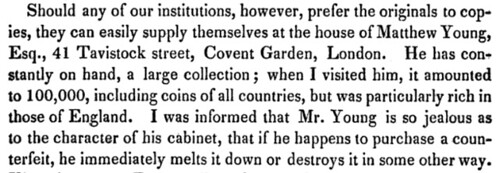
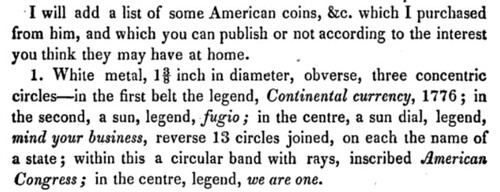
David McCarthy writes:
Regarding the exploration of possible sources for the pieces in Germany, Bill Eckberg writes:
WHAT'S NEXT FOR THE CONTINENTAL DOLLAR?
(http://www.coinbooks.org/v21/esylum_v21n29a10.html)

BEARDLESS BREEN ON RADIO WITH 1943 BRONZE CENT
SUMMER SEMINAR BOOK SALE FINDS
(http://www.coinbooks.org/v21/esylum_v21n27a22.html)
MORE BREEN AND TAXAY AUTHENTICATION CERTIFICATES
(http://www.coinbooks.org/v21/esylum_v21n28a12.html)
WALTER BREEN AT COIN WORLD AND BEYOND
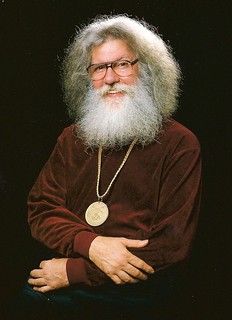 Regarding Walter Breen experiences... When I joined the writing staff at Coin World early in 1974, I was made vividly aware of Breen's standing with publisher Amos Press. Staff writers took stuff to write from the "must list," material to be written NOW. Among items assigned to me was a handsome
reprint of Dr. Edward Maris' classic work on Colonial Coins of New Jersey, a massive though thin hardback made noteworthy by updates and revisions added by "Walter Breen." My review noted, quite properly I thought, that the new material by Breen was a major reason to buy the book.
Regarding Walter Breen experiences... When I joined the writing staff at Coin World early in 1974, I was made vividly aware of Breen's standing with publisher Amos Press. Staff writers took stuff to write from the "must list," material to be written NOW. Among items assigned to me was a handsome
reprint of Dr. Edward Maris' classic work on Colonial Coins of New Jersey, a massive though thin hardback made noteworthy by updates and revisions added by "Walter Breen." My review noted, quite properly I thought, that the new material by Breen was a major reason to buy the book.
WALTER BREEN BIOGRAPHY
(http://www.coinbooks.org/esylum_v05n26a11.html)
TALE OF THE TAPE: PITTMAN, BREEN AND THE TAXAY BOOK BLURB
(http://www.coinbooks.org/esylum_v17n04a10.html)
CONFRONTING THE LEGACY OF WALTER BREEN
(http://www.coinbooks.org/esylum_v18n45a11.html)
THE BOOK BAZARRE
BOOK CUTTING IDENTIFICATION THOUGHTS
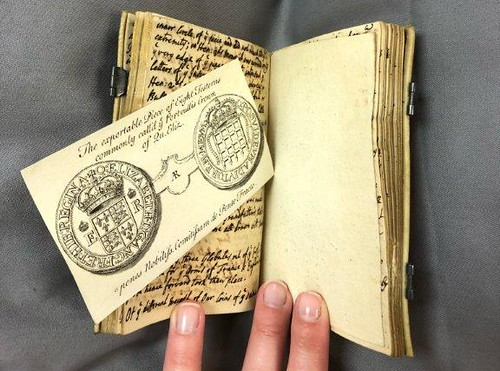
David Pickup's Mystery Book Cutting
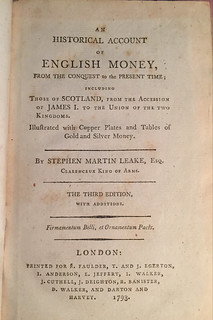
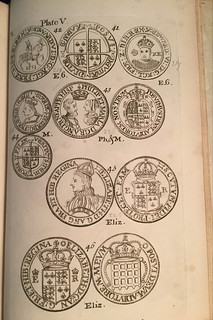 Leake 3rd Edition
Leake 3rd Edition
NOTES FROM E-SYLUM READERS: JULY 22, 2018 : Query: Book Cutting Identification Sought
(http://www.coinbooks.org/v21/esylum_v21n29a17.html)
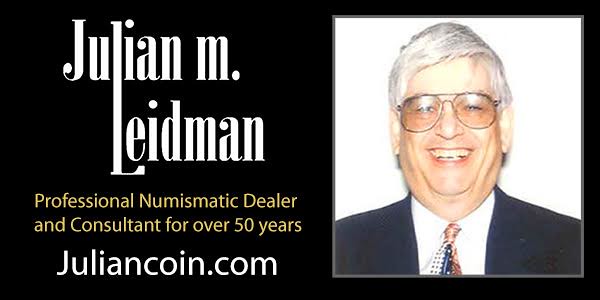
NOTES FROM E-SYLUM READERS: JULY 29, 2018
Michael T. Shutterly writes:
Rex Stark writes:
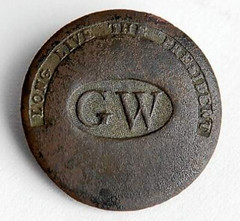 Regarding the metal detector find of the four George Washington buttons - there are several errors and/or misconceptions in the article. While the buttons are obviously genuine, having the Dept. of the Interior "authenticate" them is meaningless. You might as well have them authenticated by your auto mechanic.
Regarding the metal detector find of the four George Washington buttons - there are several errors and/or misconceptions in the article. While the buttons are obviously genuine, having the Dept. of the Interior "authenticate" them is meaningless. You might as well have them authenticated by your auto mechanic.
WASHINGTON INAUGURAL BUTTONS FOUND
(http://www.coinbooks.org/v21/esylum_v21n29a16.html)


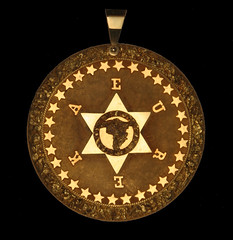
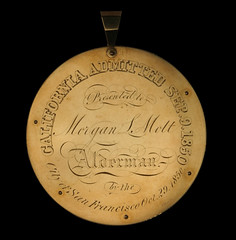
https://nnp.wustl.edu/library/ImageDetail/510943
https://nnp.wustl.edu/library/ImageDetail/510944
QUERY: SAN FRANCISCO COMMITTEE OF VIGILANCE MEDAL
(http://www.coinbooks.org/v21/esylum_v21n29a09.html)
Numismatic literature dealer George Kolbe writes:
KOLBE SALE 87 RESULTS
(http://www.coinbooks.org/esylum_v05n14a02.html)
NOTES FROM E-SYLUM READERS: JULY 22, 2018 : On Treating Musty-Smelling Books
(http://www.coinbooks.org/v21/esylum_v21n29a17.html)
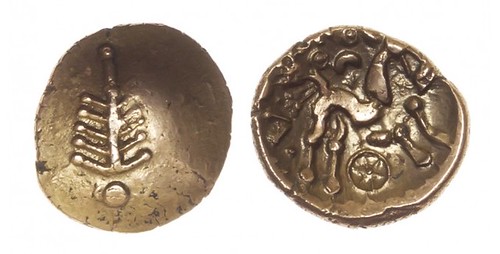
Celtic Coinage of Britain
(http://www.vanarsdellcelticcoinageofbritain.com/)
NUMISMATIC NUGGETS: JULY 22, 2018 : Corio, Gold Stater
(http://www.coinbooks.org/v21/esylum_v21n29a27.html)
David Lange of Numismatic Guaranty Corporation writes:
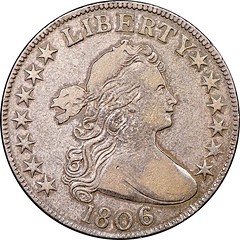
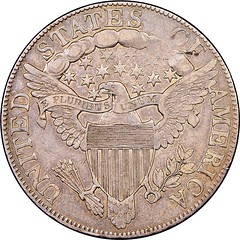
NGC Attribution: O-108
Overton's Obverse 4 was used in three die marriages, the most notable of which is the present one. O-108 pairs this die with Reverse F, which is one of two "No Stem" dies for the date and is unique to this marriage.
Unlike the common O-109, which features a "No Stem" reverse and a Pointed 6 obverse, this very rare (R-7) die marriage is distinctive for its "Knobbed 6" date.
https://www.ngccoin.com/variety-plus/united-states/half-dollars/4735/817378/
NUMISMATIC NUGGETS: JULY 22, 2018 : 1806 Half Dollar, O-108
(http://www.coinbooks.org/v21/esylum_v21n29a27.html)
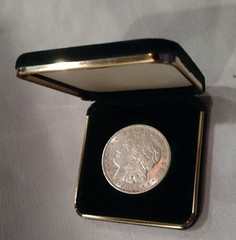 Todd Pollock writes:
Todd Pollock writes:
WAYNE'S NUMISMATIC DIARY: JULY 15, 2018 : U.S. Mint Silver Dollar Box
(http://www.coinbooks.org/v21/esylum_v21n28a23.html)
NOTES FROM E-SYLUM READERS: JULY 22, 2018 : U.S. Mint Green Display Boxes
(http://www.coinbooks.org/v21/esylum_v21n29a17.html)
Dick Grinolds writes:

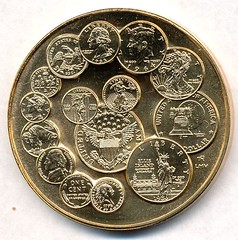

Dunsmore: Washington Inspecting the First Money
Coined by the United States
PAINTING RECREATES JEFFERSON'S COIN TRANSACTION
(http://www.coinbooks.org/v21/esylum_v21n27a24.html)
Regarding the United States Agricultural Society medal discussed recently,
Tony Terranova writes:
MORE ON U.S. AGRICULTURAL SOCIETY MEDALS
(http://www.coinbooks.org/v21/esylum_v21n29a18.html)

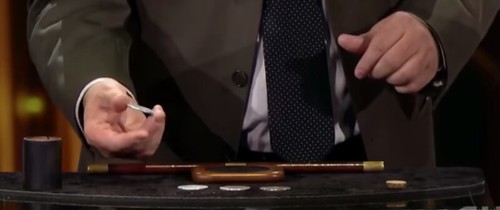
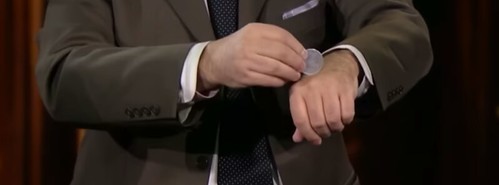
Extremely VISUAL Coin Magic Trick Completely CONFUSES Penn & Teller!
(https://www.youtube.com/watch?v=HKUB6dybmIs)
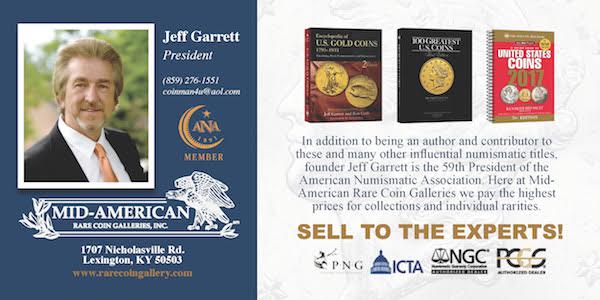
PNG AUTHENTICATION CERTIFICATES
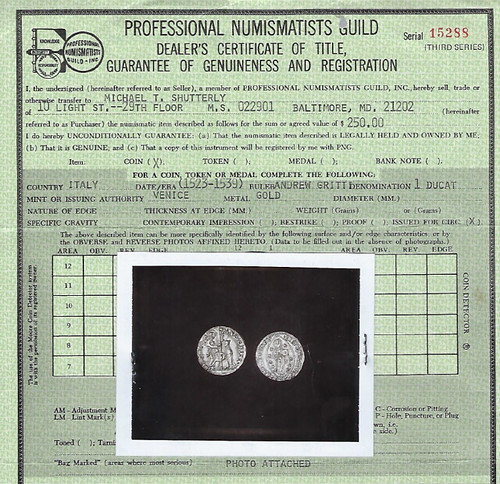
PNG Authentication Certificate (Front - top only)
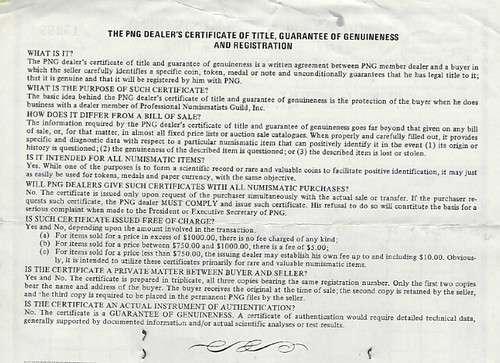
PNG Authentication Certificate (Back - top only)
NOTES FROM E-SYLUM READERS: JULY 22, 2018 : PNG Authentication Certificates
(http://www.coinbooks.org/v21/esylum_v21n29a17.html)

NUMIS-MAILRS
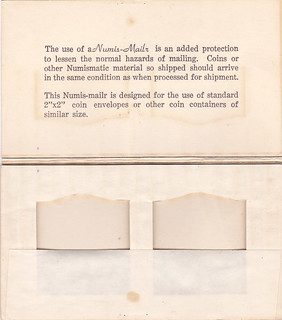

Left: Inside of Numis-Mailr with two 2x2 size pockets
Right: Outside of Numis-Mailr with three ads
NOTES FROM E-SYLUM READERS: JULY 22, 2018 : PNG Authentication Certificates
(http://www.coinbooks.org/v21/esylum_v21n29a17.html)
VOCABULARY TERM: BASE LINE
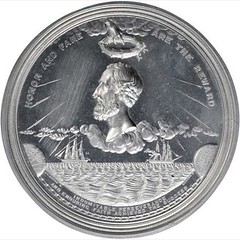
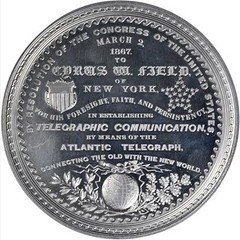
CLASS 02.4
O37 {1977} JULIAN.
CLASS 02.4
CLASS 02.4
O37 {1977} Julian.
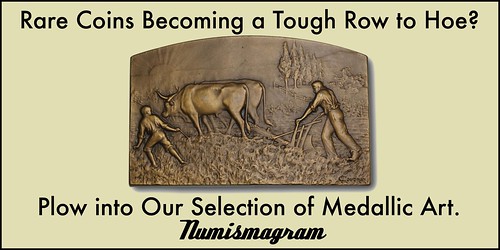
WILLIAM FREDERICK FRATCHER (1867-1947)
 Around late Fall or Winter Fratcher traded Dr. George Francis Heath (1850-1908), of Monroe, Michigan, a small 12" x 8' printing press in exchange for a collection of postage stamps. A few years later in 1888, Dr. Heath began to print The American Numismatist on this press with help from Fratcher getting the press to work properly.
Around late Fall or Winter Fratcher traded Dr. George Francis Heath (1850-1908), of Monroe, Michigan, a small 12" x 8' printing press in exchange for a collection of postage stamps. A few years later in 1888, Dr. Heath began to print The American Numismatist on this press with help from Fratcher getting the press to work properly.
 In October 1898 he advertised buying U. S. Postage Stamps in the Detroit Free Press, Sunday, October 16, 1898, page 21. On November 13th the ad included Canadian and Revenue stamps. In September 1899 he advertised looking for pre-1851 canceled U. S. Postage Stamps.
In October 1898 he advertised buying U. S. Postage Stamps in the Detroit Free Press, Sunday, October 16, 1898, page 21. On November 13th the ad included Canadian and Revenue stamps. In September 1899 he advertised looking for pre-1851 canceled U. S. Postage Stamps.
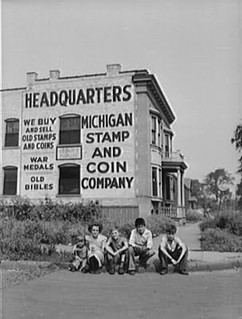 The 1917 Detroit City Directory lists him as the president of the Michigan Stamp & Coin Company. The Confectionery, Ice-Cream and Cigar store are now listed as run by his son Vernon C. Fratcher.
The 1917 Detroit City Directory lists him as the president of the Michigan Stamp & Coin Company. The Confectionery, Ice-Cream and Cigar store are now listed as run by his son Vernon C. Fratcher.
FRATCHER, WILLIAM FREDERICK
(https://sites.google.com/a/numismaticmall.com/www/numismaticmall-com/fratcher-william-frederick)
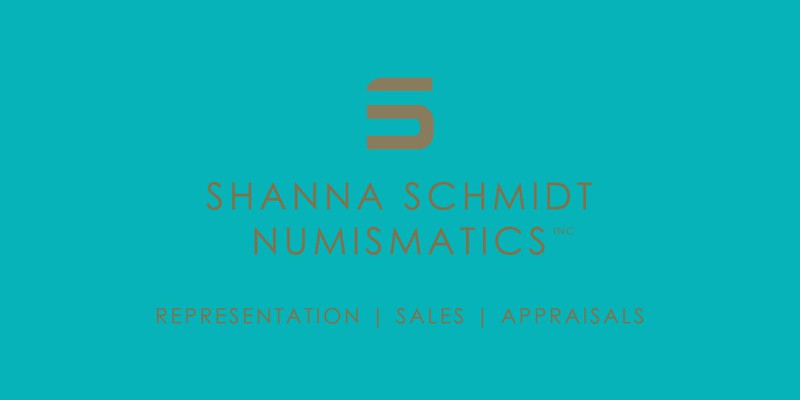
THE FIRST ANS ERIC P. NEWMAN VISITING SCHOLAR
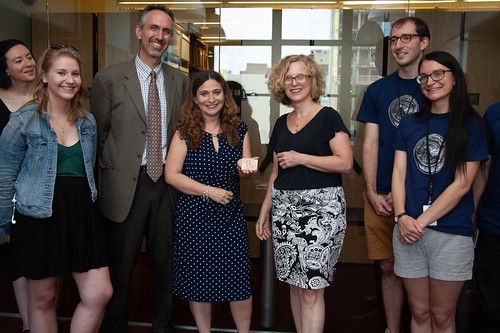
http://numismatics.org/seminar/
ANA ANNOUNCES 2018 HIGHEST HONOR AWARDS
The Farran Zerbe Memorial Award for Distinguished Service is the highest honor conferred by the American Numismatic Association. It is given in recognition of numerous years of outstanding, dedicated service to numismatics. Cindy Wibker is the recipient of this year’s award.
The Numismatist of the Year, first presented in 1995, was established to recognize individuals within the numismatic community who have demonstrated long-term leadership in the field and to the American Numismatic Association. This year’s recipient is David J. McCarthy.
The American Numismatic Association recognizes that the future of the hobby depends on the recruitment and education of young numismatists. The Young Numismatist of the Year award honors young collectors for outstanding contributions to the hobby and industry. Recipients exhibit a positive attitude, strong communication skills, cooperation, dependability and avid interest in expanding their numismatic knowledge. Receiving this year’s award is Abigail Zechman.
The Lifetime Achievement Award is presented to an individual, family, firm or judicial entity that has made outstanding contributions to organized numismatics. Energetic, organized and seldom without his clipboard in hand, life member and National Exhibit Coordinator Mark Lighterman is the 2018 recipient. Lighterman will be honored during the World’s Fair of Money in Philadelphia.
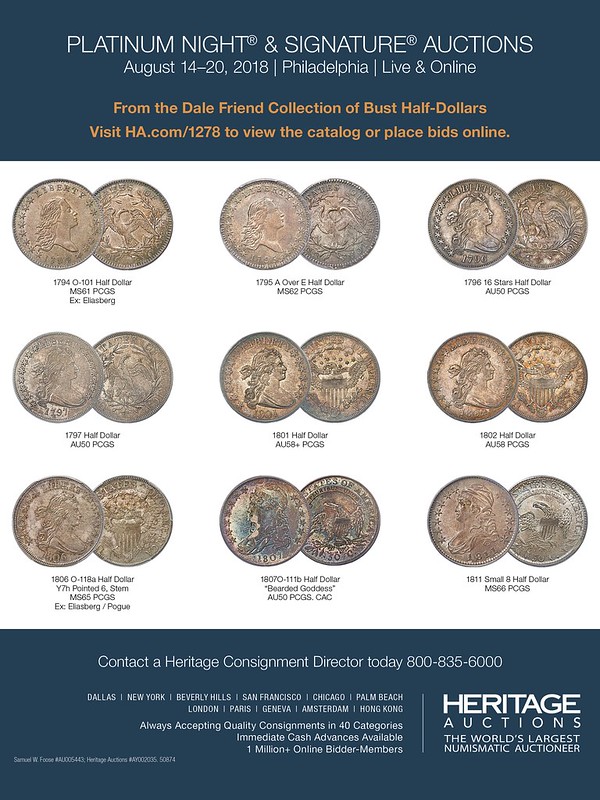
2018 ANA PHILADELPHIA WFOM VOLUNTEER BUTTONS
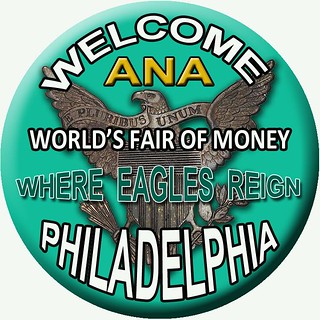
WORLD'S FAIR OF MONEY
Philadelphia, PA — August 14-18, 2018
(https://www.money.org/worldsfairofmoney)
PCGS TO EXHIBIT BRASHER DOUBLOON AT 2018 WFOM
PCGS Exhibit at ANA Philadelphia Show
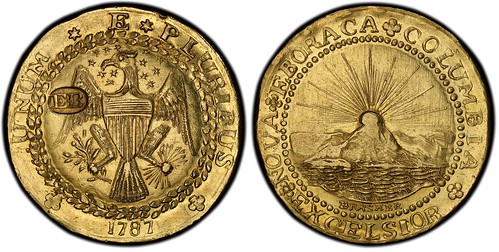
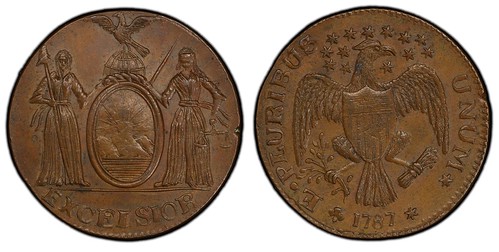
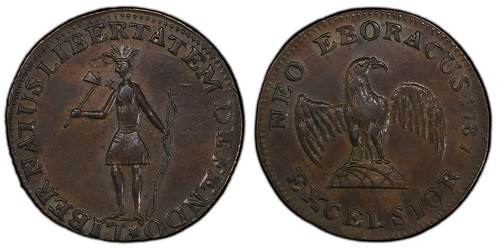

WILLIAM AND CHARLES BARBER EXHIBITS AT 2018 WFOM
HISTORIC EXHIBIT IN PHILADELPHIA
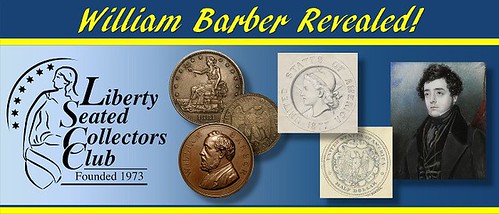
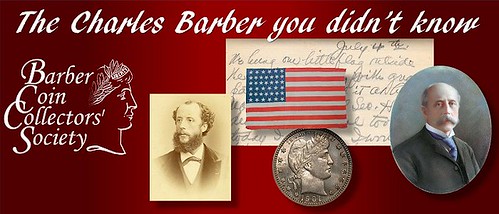
THE BOOK BAZARRE
ANA STUDENT EDUCATIONAL KITS
STACK'S BOWERS HONG KONG PRIMITIVE MONEY LOTS

CHINA. Brass Charm Tree, ND. Changsha Mint. Qian Long (1736-95).
(https://auctions.stacksbowers.com/lots/view/3-BF7W1)

CHINA. Brass Money Tree, ND. Qian Long (1736-95).
(https://auctions.stacksbowers.com/lots/view/3-BF7W4)

CHINA. Brass Money Tree, ND (ca. 1875-1908).
(https://auctions.stacksbowers.com/lots/view/3-BF6K0)

MALAYSIA. Kedah. Tin Animal Money, ND (ca. Mid-18th Century). Sultan Muhammad Jiwa Zanial Abidin Muassam Shah (1710-73).
(https://auctions.stacksbowers.com/lots/view/3-BFCZ7)
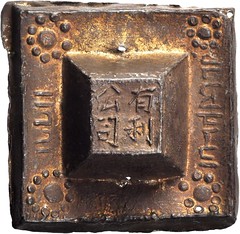
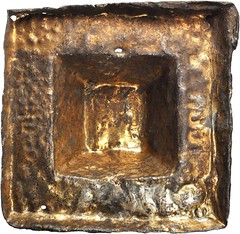
MALAYSIA. Pahang. 1/25 Dollar Tampang Tin Hat Money, ND (ca. 1850's to Early 1860's).
(https://auctions.stacksbowers.com/lots/view/3-BFCZE)
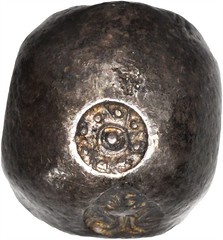
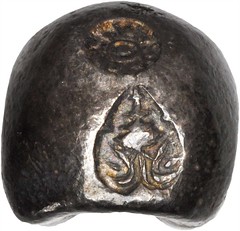
THAILAND. 4 Baht (Tamlung) Bullet Money, ND. Mongkut (Rama IV) (1851-68).
(https://auctions.stacksbowers.com/lots/view/3-BFCYM)

STACK'S BOWERS ANA PRIMITIVE MONEY HIGHLIGHTS
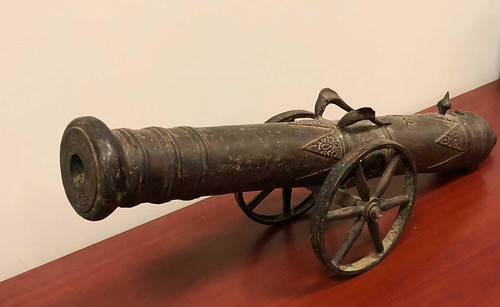
MALAYA. Lantaka Dutch Cannon Money, ND (ca. 16th to Early 20th Century).
(https://auctions.stacksbowers.com/lots/view/3-BGMAO)
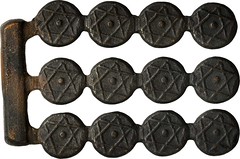
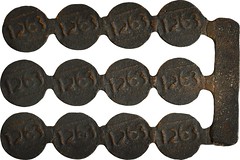
Morocco. Falus Bronze Casting Tree, AH 1263 (1846/7). Moulay 'Abd al Rahman (AH 1238-76 (1822-59)).
(https://auctions.stacksbowers.com/lots/view/3-BGMB6)
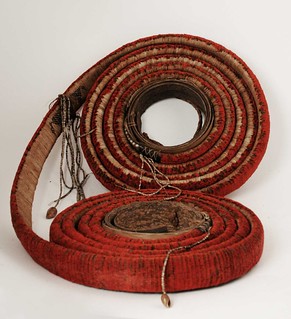 Approximately 2 in x 30 ft. Optiz-pg.142; Bowers Museum-2001.74.14. EXTREMELY RARE and extremely difficult to obtain an intact coil. Each coil takes about one year's labor by three specialists, the bird snarer, the platelet maker and the currency binder. Each coil requires a minimum of 300 Honey eater birds with a total of at least 1,500 platelets. A single bird could be used to make up to five platelets each using only the feathers from the breast, head and back of the bird. Also known as Tau, Tirrau, Tavau and Temotu these coils were used in bride price which consisted of 10 coils.
Approximately 2 in x 30 ft. Optiz-pg.142; Bowers Museum-2001.74.14. EXTREMELY RARE and extremely difficult to obtain an intact coil. Each coil takes about one year's labor by three specialists, the bird snarer, the platelet maker and the currency binder. Each coil requires a minimum of 300 Honey eater birds with a total of at least 1,500 platelets. A single bird could be used to make up to five platelets each using only the feathers from the breast, head and back of the bird. Also known as Tau, Tirrau, Tavau and Temotu these coils were used in bride price which consisted of 10 coils.
SOLOMON ISLANDS. Santa Cruz. Honey Eater Bird Feather Coil, ND.
(https://auctions.stacksbowers.com/lots/view/3-BGM9N)
 Approximately 19 x 15 x 4 in; Approximately 74 lbs. Opitz-pg. 316/21; Quiggin-pg. 144, pl#12; Sigler-P.19. Yap Island produced the world's largest and heaviest coinage, most commonly referred to as "Fei" or "Rai", considered sacred amongst the local people. The largest examples are in excess of 12 feet in diameter, weighing about 2 tons. Due to their excessive size, the larger stones often traded ownership without physically being moved and would remain in place as it became common knowledge among the inhabitants that it now belonged to a new owner.
Approximately 19 x 15 x 4 in; Approximately 74 lbs. Opitz-pg. 316/21; Quiggin-pg. 144, pl#12; Sigler-P.19. Yap Island produced the world's largest and heaviest coinage, most commonly referred to as "Fei" or "Rai", considered sacred amongst the local people. The largest examples are in excess of 12 feet in diameter, weighing about 2 tons. Due to their excessive size, the larger stones often traded ownership without physically being moved and would remain in place as it became common knowledge among the inhabitants that it now belonged to a new owner.
Yap Island. Stone Money "Fei" & Banana Fiber and Hibiscus Fiber Mat, ND (ca. Late 19th Century or Earlier). Pre O'Keefe Type.
(https://auctions.stacksbowers.com/lots/view/3-BGMAF)
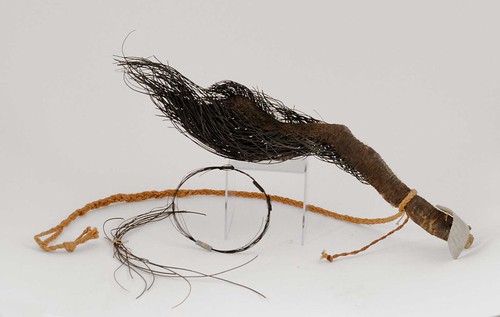
Africa. Congo, Kenya & French Cameroon. Elephant Tail Hair Money, ND (ca. 19th Century).
(https://auctions.stacksbowers.com/lots/view/3-BGM9U)

23661 CONGO. Liganda "Doa" Iron Spearhead Money, ND (ca. 19th to 1920's).
(https://auctions.stacksbowers.com/lots/view/3-BI8TT)
 cf.Opitz-pg. 79(for beetle wings). The two strands consist of 34 and 31 wings attached to woven sting, numerous chips and cracks. The strand of approximately 294 beetle legs is mounted to a piece of thick card stock, some are cracked, chipped or broken; not listed in Opitz. Despite the noted defects of these very fragile items a beautiful display of the iridescent colors that these wings and legs possess. RARE and interesting.
cf.Opitz-pg. 79(for beetle wings). The two strands consist of 34 and 31 wings attached to woven sting, numerous chips and cracks. The strand of approximately 294 beetle legs is mounted to a piece of thick card stock, some are cracked, chipped or broken; not listed in Opitz. Despite the noted defects of these very fragile items a beautiful display of the iridescent colors that these wings and legs possess. RARE and interesting.
PAPUA NEW GUINEA. Beetle Wing Strands & Beetle Leg Money, ND.
(https://auctions.stacksbowers.com/lots/view/3-BI8U7)
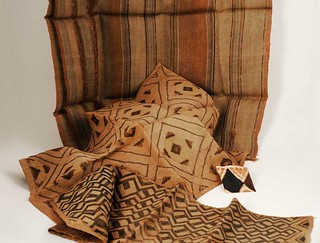 Opitz-pg.107/11. 7 pieces in lot. An interesting assortment of trade cloths mainly used in bride price, but were also used for other transactions to purchase house hold items such as goats, slaves and other necessities. Pieces of note include an intricately woven cloth with geometric designs (approximately 10 x 25.5 in) from Angola, a finely woven cloth with brown multi-color diamond shapes evenly spaced with diagonal parallel lines in between (approximately 17 x 25.5 in) from Benin and a finely woven brown striped cloth with two sections running the length which are loosely woven (approximately 24.5 in x 5.5 ft) from Belgian Congo.
Opitz-pg.107/11. 7 pieces in lot. An interesting assortment of trade cloths mainly used in bride price, but were also used for other transactions to purchase house hold items such as goats, slaves and other necessities. Pieces of note include an intricately woven cloth with geometric designs (approximately 10 x 25.5 in) from Angola, a finely woven cloth with brown multi-color diamond shapes evenly spaced with diagonal parallel lines in between (approximately 17 x 25.5 in) from Benin and a finely woven brown striped cloth with two sections running the length which are loosely woven (approximately 24.5 in x 5.5 ft) from Belgian Congo.
Africa. Angola, Belgian Congo & Benin. Trade Cloth, ND (ca. 19th Century)
(https://auctions.stacksbowers.com/lots/view/3-BI8TJ)
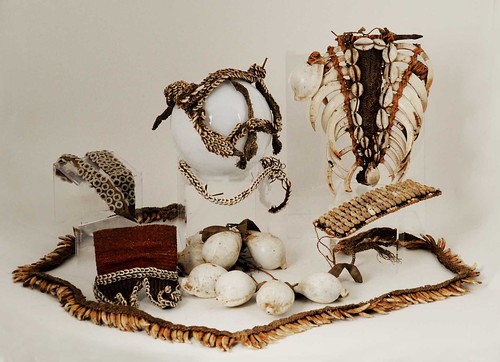
PACIFIC RIM. Papua New Guinea, Admiralty Islands, Guadalcanal, San Cristobal, Manus Province. Dog Teeth, Shell Ornaments and Buttons, ND...
(https://auctions.stacksbowers.com/lots/view/3-BI8SL)
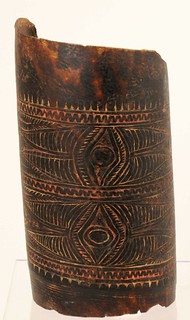 PACIFIC RIM. New Britain. Navoi (Tortoise-Shell Armband), ND (ca. 19th Century).
PACIFIC RIM. New Britain. Navoi (Tortoise-Shell Armband), ND (ca. 19th Century).
PACIFIC RIM. New Britain. Navoi (Tortoise-Shell Armband), ND (ca. 19th Century).
(https://auctions.stacksbowers.com/lots/view/3-BI8SW)

HIGHLIGHTS OF HERITAGE AUGUST 2018 PLATINUM SALE
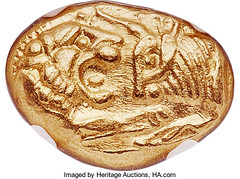
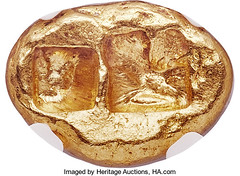
Ancients: LYDIAN KINGDOM. Croesus and later (ca. 561-546 BC). AV stater (17mm, 8.08 gm). NGC Gem MS 5/5 - 5/5....
(https://coins.ha.com/itm/ancients/greek/ancients-lydian-kingdom-croesus-and-later-ca-561-546-bc-av-stater-17mm-808-gm-ngc-gem-ms-5-5-5-5/a/3066-30059.s)
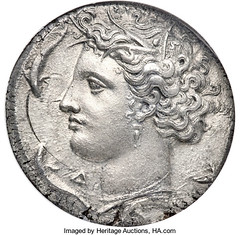
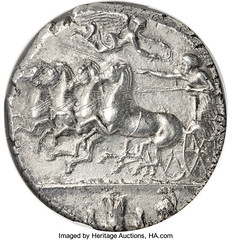
Ancients: SICILY. Syracuse. Time of Dionysius I (ca. 405-370 BC). AR decadrachm (33mm, 43.11 gm, 8h). NGC Choice AU 5/...
(https://coins.ha.com/itm/ancients/greek/ancients-sicily-syracuse-time-of-dionysius-i-ca-405-370-bc-ar-decadrachm-33mm-4311-gm-8h-ngc-choice-au-5-/a/3066-30005.s)
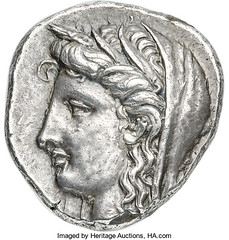
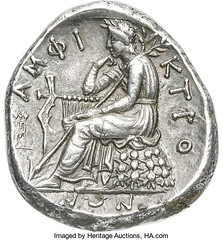
Ancients: PHOCIS. Delphi. Ca. 338-334 BC. AR stater (24mm, 12.29 gm, 6h). NGC (photo-certificate) AU ? 5/5 - 5...
(https://coins.ha.com/itm/ancients/greek/ancients-phocis-delphi-ca-338-334-bc-ar-stater-24mm-1229-gm-6h-ngc-photo-certificate-au-and-9733-5-5-5/a/3066-30032.s)
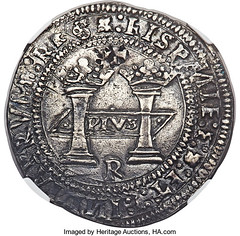
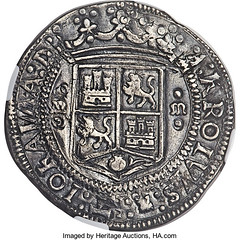
Mexico: Charles and Johanna "Early Series" Rincón 8 Reales ND (c. 1538) •M•-•M• AU50 NGC,.
(https://coins.ha.com/itm/mexico/mexico-charles-and-johanna-early-series-rincon-8-reales-nd-c-1538-omo-omo-au50-ngc-/a/3066-30386.s)
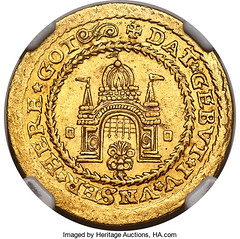
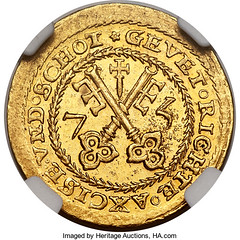
Poland: Riga. Free City gold 2 Ducat 1575-Dated MS62 NGC,...
(https://coins.ha.com/itm/poland/poland-riga-free-city-gold-2-ducat-1575-dated-ms62-ngc-/a/3066-30405.s)
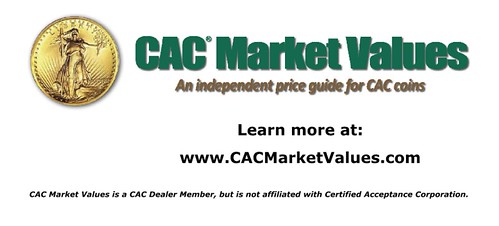
NUMISMATIC NUGGETS: JULY 29, 2018
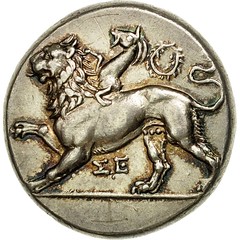

COIN, SIKYONIA, SICYON, STATER, AU(55-58), SILVER, BCD PELOPONNESOS:219
(https://www.numiscorner.com/collections/whats-new/products/coin-sikyonia-sicyon-stater-au55-58-silver-bcd-peloponnesos-219)
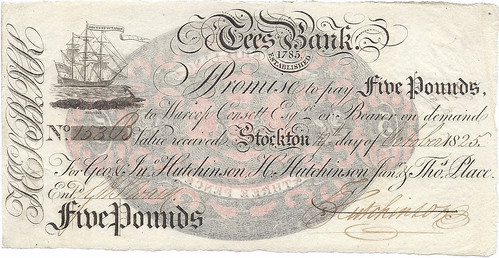
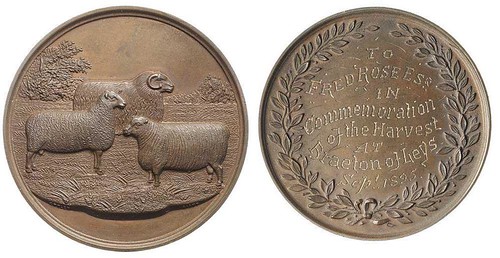
Lot 1515: Great Britain - Historical Medals
(https://www.invaluable.com/auction-lot/great-britain-historical-medals-E0A4A84BD9)
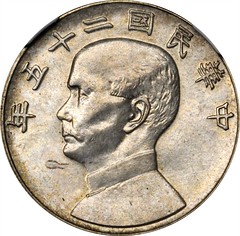
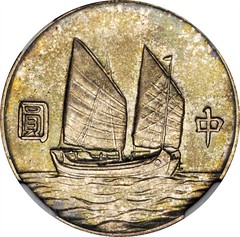
60477 CHINA. Pattern 1/2 Dollar (50 Cents), Year 25 (1936). San Francisco Mint. NGC MS-63
(https://auctions.stacksbowers.com/lots/view/3-BF57D)
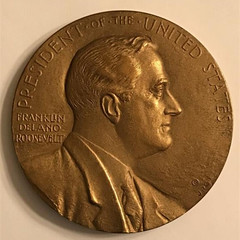
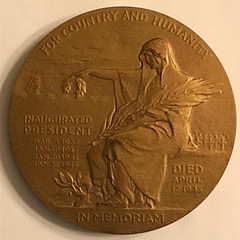
Lot 1043: 1945 Commemorative Medal
(https://www.invaluable.com/auction-lot/-1-c-7114E33800)

ARCHIVES INTERNATIONAL SALE 49
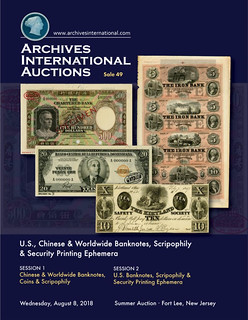 The August 8th auction by Archives International Auctions will feature over 1040 lots of
rare and desirable U.S. & Worldwide Banknotes, Scripophily and Security Printing Ephemera including
two large groups of De La Rue Specimen Banknotes featuring the Hammurabi Collection of Serial #13
Specimen Notes as well as a desirable collection of De La Rue Specimen notes consigned by the family of
a banker from El Salvador; the second offering from The American Bank Note Commemoratives
Inventory of U.S. Obsolete Banknote & Worldwide Banknote Souvenir Cards, Philatelic Cards &
Miscellaneous Ephemera; U.S. obsolete banknotes from an old estate collection; a desirable Alaska
Token Collection , as well as numerous consignments and hundreds of additional banknotes, stocks,
bonds, and autographs.
The August 8th auction by Archives International Auctions will feature over 1040 lots of
rare and desirable U.S. & Worldwide Banknotes, Scripophily and Security Printing Ephemera including
two large groups of De La Rue Specimen Banknotes featuring the Hammurabi Collection of Serial #13
Specimen Notes as well as a desirable collection of De La Rue Specimen notes consigned by the family of
a banker from El Salvador; the second offering from The American Bank Note Commemoratives
Inventory of U.S. Obsolete Banknote & Worldwide Banknote Souvenir Cards, Philatelic Cards &
Miscellaneous Ephemera; U.S. obsolete banknotes from an old estate collection; a desirable Alaska
Token Collection , as well as numerous consignments and hundreds of additional banknotes, stocks,
bonds, and autographs.
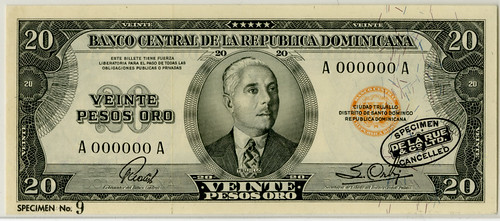
Lot 236. Banco Central De La Republica Dominicana, ND (1952) Specimen Banknote

Lot 241. East Caribbean Currency Authority, ND (1965) $20, Specimen Banknote

Lot 319. Hong Kong. The Chartered Bank (1962-75) Specimen Banknote
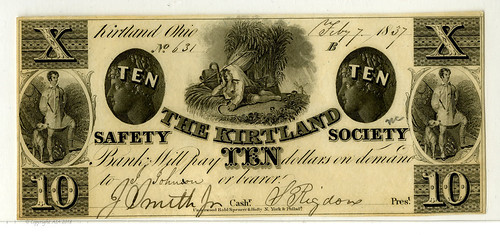
Lot 580. Ohio. Kirtland Safety Society Bank 1837 $10 Issued Obsolete Banknote
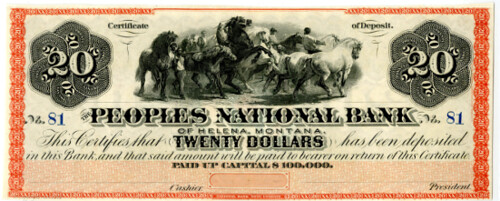
Lot 598. Peoples National Bank, of Helena, Montana, $20 CD 1870s Obsolete Banknote

Lot 614. Republic of Texas, 1840, $50 Obsolete Banknote
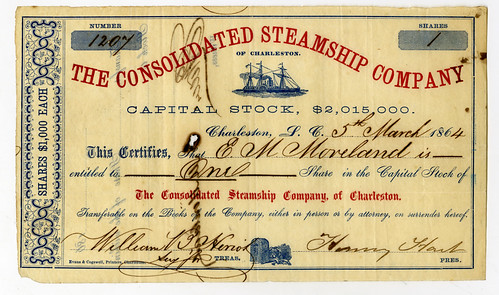
Lot 808. Consolidated Steamship Co. 1864 Blockade Runner Stock Certificate
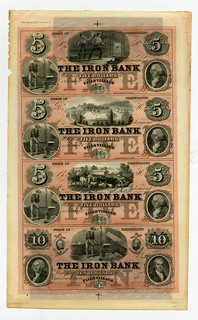
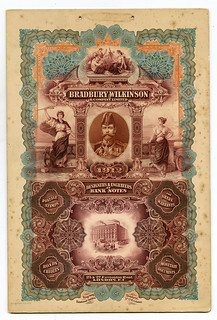
Left: Lot 581. Iron Bank, 1850-60's Uncut Full Color Obsolete Sheet of 4 Notes
Right: Lot 655. Bradbury Wilkinson & Company, Ltd. 1912 Adv Poster.

HORNBY ISLAND MUNICIPAL TRADE TOKENS

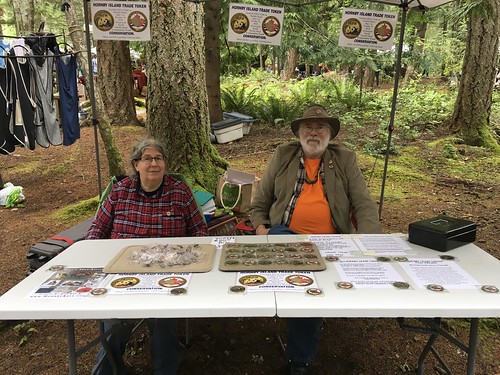
Barbara and Jim Bulmer
WORCESTERSHIRE MEDAL SERVICE WINS CONTRACT
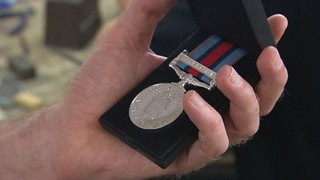 A family-run firm has won an £11m contract to produce military medals.
A family-run firm has won an £11m contract to produce military medals.
Birmingham family firm wins £11m military medals deal
(https://www.bbc.com/news/uk-england-birmingham-44970111)
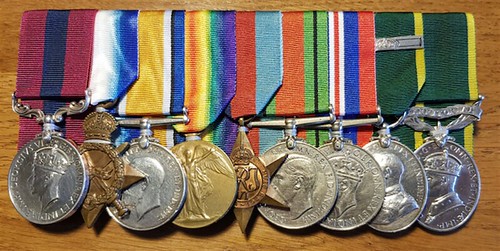
https://www.worcmedals.com/
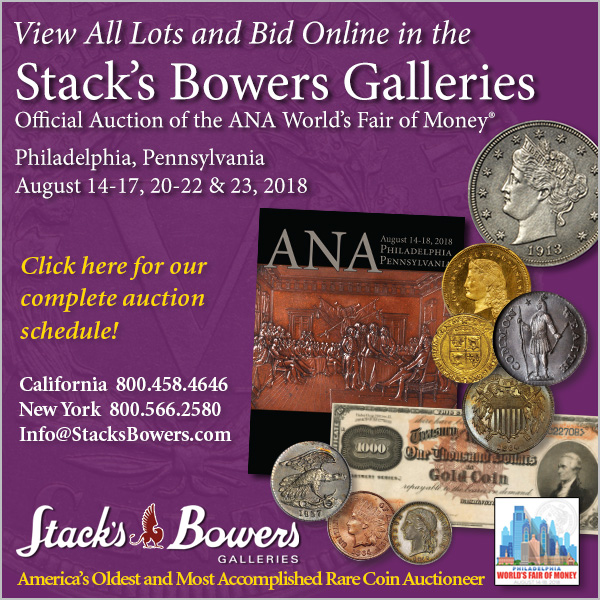
SERIAL NO. 1 CANADIAN $20 NOTE FOUND
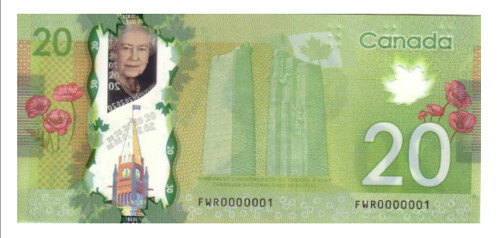
Serial No. 1 Canadian $20 note found
(http://canadiancoinnews.com/three-low-serial-number-notes-including-a-no-1-found-by-quebec-collector/)

NEW HONG KONG BANKNOTES UNVEILED

Hidden numerals, fluorescent colors to defy banknote copycats
(http://www.thestandard.com.hk/breaking-news.php?id=110972&sid=4)

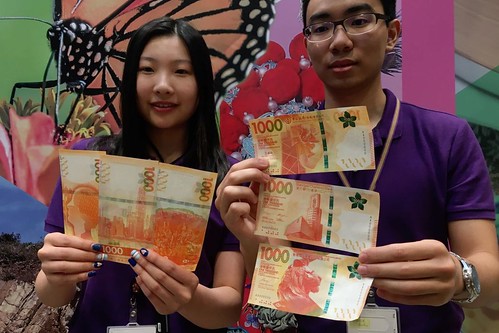
In Pictures: Hong Kong reveals new banknote designs
(https://www.hongkongfp.com/2018/07/24/pictures-hong-kong-reveals-new-banknote-designs/)
People are mocking Hong Kong’s new $100 bill for resembling “hell money”
(https://qz.com/1335804/hong-kongs-100-bill-is-mocked-for-resembling-hell-money/)
CHINESE HELL MONEY
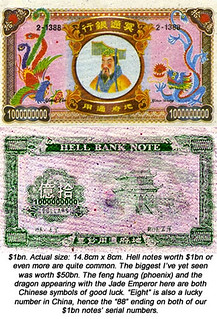 Hell money springs from a very old tradition in Chinese culture, arguably stretching back as far as 1600 BC. Archaeologists have found tombs of that era in China with imitation metal money placed among the human remains. China has been using some form of paper money since the 9th Century, and paper money’s been dominant there for nearly 800 years. Joss paper copies of this money have been burned at funerals and graves for almost as long, and some people still prefer to use this form of spirit “cash” in paying their respects today.
Hell money springs from a very old tradition in Chinese culture, arguably stretching back as far as 1600 BC. Archaeologists have found tombs of that era in China with imitation metal money placed among the human remains. China has been using some form of paper money since the 9th Century, and paper money’s been dominant there for nearly 800 years. Joss paper copies of this money have been burned at funerals and graves for almost as long, and some people still prefer to use this form of spirit “cash” in paying their respects today.
Satan’s own bankers: Chinese Hell money
(http://www.planetslade.com/hell-money.html)
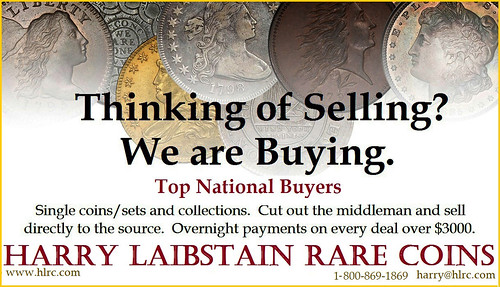
VENEZUELA DROPS TWO MORE ZEROS
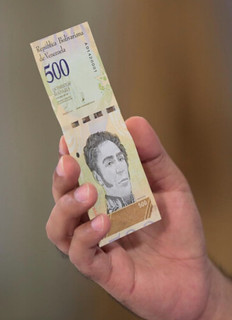 Venezuela will remove five zeroes from the bolivar currency rather than the three zeroes originally planned, President Nicolas Maduro said on Wednesday, in an effort to keep up with inflation projected to reach 1 million percent this year.
Venezuela will remove five zeroes from the bolivar currency rather than the three zeroes originally planned, President Nicolas Maduro said on Wednesday, in an effort to keep up with inflation projected to reach 1 million percent this year.
Venezuela to remove five zeroes from ailing currency
(https://www.reuters.com/article/us-venezuela-economy/venezuela-to-remove-five-zeroes-from-ailing-currency-idUSKBN1KF36V)
VENEZUELA PONDERS DROPPING THREE ZEROS
(http://www.coinbooks.org/v21/esylum_v21n12a35.html)
VENEZUELA'S WORTHLESS BANKNOTES
(http://www.coinbooks.org/v21/esylum_v21n29a34.html)
Iran's currency in free fall as American sanctions loom following U.S. decision to withdraw from nuclear deal
(http://www.dailymail.co.uk/news/article-6004011/Irans-currency-free-fall-American-sanctions-loom.html)
ZIMBABWE'S MONEY CHANGERS
 People think money-changing is a lawless business, but it actually has a lot of unofficial rules.
People think money-changing is a lawless business, but it actually has a lot of unofficial rules.
Zimbabwe election: Hustling for cash to survive
(https://www.bbc.com/news/world-africa-44971474)
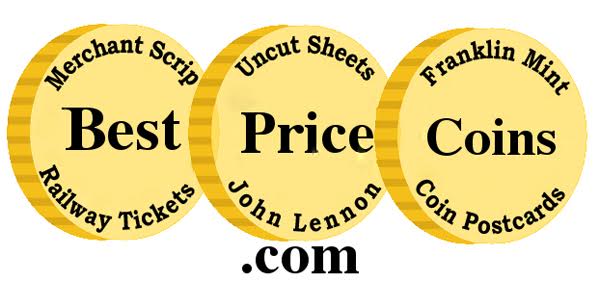
FRANCE CONSIDERS ELIMINATING SMALLEST COINS
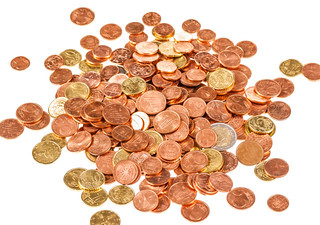 France could soon abolish its one and two centime coins in a first step towards creating a zero-cash economy.
The days of those pesky one and two centime coins which fill your wallet, pocket or purse and accumulate around the house could be numbered.
France could soon abolish its one and two centime coins in a first step towards creating a zero-cash economy.
The days of those pesky one and two centime coins which fill your wallet, pocket or purse and accumulate around the house could be numbered.
Cashing out: France mulls ditching one and two centime coins
(https://www.thelocal.fr/20180723/france-mulls-ditching-one-and-two-cent-coins)
CASHLESS STORES AND RESTAURANTS ON THE RISE
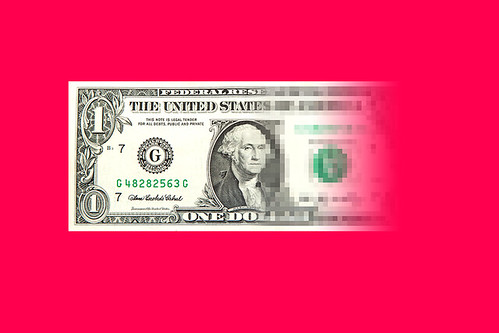
No Shirt, No Swipe, No Service
(https://slate.com/business/2018/07/cashless-stores-and-restaurants-are-on-the-rise-to-the-delight-of-credit-card-companies.html)
EVERLEDGER: BLOCKCHAIN TECHNOLOGY FOR ART WORLD
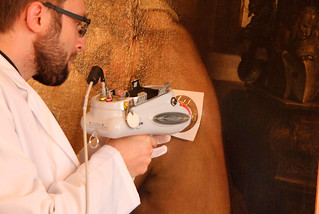 Everledger, an independent emerging technology enterprise, and The True Image Solution Ltd (TIS), a leading research company on evaluation and restoration of cultural heritage objects, have today announced a collaboration to combine blockchain technology with forensic artwork reporting.
Everledger, an independent emerging technology enterprise, and The True Image Solution Ltd (TIS), a leading research company on evaluation and restoration of cultural heritage objects, have today announced a collaboration to combine blockchain technology with forensic artwork reporting.
Everledger and TIS drive new breakthrough standard in fine art authentication
(http://artdaily.com/news/106489/Everledger-and-TIS-drive-new-breakthrough-standard-in-fine-art-authentication#.W1rl0dJKiAs)
BRONZECHAIN: NEW HALLMARK FOR BRONZE
(http://www.coinbooks.org/v21/esylum_v21n15a39.html)
LIVEAUCTIONEERS ADDS BLOCKCHAIN PROVENANCE
(http://www.coinbooks.org/v21/esylum_v21n05a25.html)
ROYAL MINT PLANS GOLD-TRACKING BLOCKCHAIN
(http://www.coinbooks.org/v20/esylum_v20n45a35.html)
IN OTHER NEWS: JULY 29, 2018
Bowers on collecting: American World’s Fairs
(http://news.coinupdate.com/bowers-on-collecting-american-worlds-fairs/)
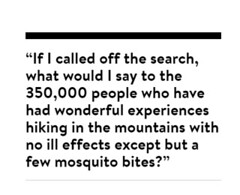 The “problem” with the plan, Fenn says, is that he recovered. Over the next several months, then years, he slowly grew stronger, and in 1993 he was declared cancer-free. After being homebound by his disease for years, Fenn was overcome with a renewed appreciation for nature and an urgent sense of purpose. “We need to get off the couch, out of the game room, and away from our electronic gadgets,” he says. He now saw his hunt as a way to entice people into the wild.
The “problem” with the plan, Fenn says, is that he recovered. Over the next several months, then years, he slowly grew stronger, and in 1993 he was declared cancer-free. After being homebound by his disease for years, Fenn was overcome with a renewed appreciation for nature and an urgent sense of purpose. “We need to get off the couch, out of the game room, and away from our electronic gadgets,” he says. He now saw his hunt as a way to entice people into the wild.
A DEADLY HUNT FOR HIDDEN TREASURE SPAWNS AN ONLINE MYSTERY
(https://www.wired.com/story/forrest-fenn-treasure-online-mystery?mbid=nl_072618_daily_list1_p1&CNDID=33563271)
TREASURE SEEKERS SEARCH FOR AUTHOR'S HIDDEN CHEST
(http://www.coinbooks.org/esylum_v18n29a41.html)
AUTHOR'S TREASURE SEARCH BRINGS ANOTHER DEATH
(http://www.coinbooks.org/v20/esylum_v20n26a35.html)
IN OTHER NEWS: JULY 15, 2018 : Forrest Fenn Interviewed
(http://www.coinbooks.org/v21/esylum_v21n28a34.html)
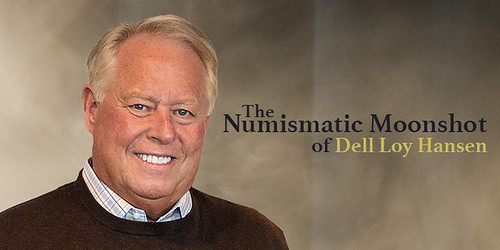
Eclipsing Eliasberg: D.L. Hansen’s Numismatic Moonshot for the Greatest Collection of All Time
(https://coinweek.com/people-in-the-news/eclipsing-eliasberg-d-l-hansens-numismatic-moonshot-for-the-greatest-collection-of-all-time/)
TODAY’S GHASTLY GROANER July 26, 2018
(http://www.cdapress.com/local_news/20180726/todays_ghastly_groaner)




